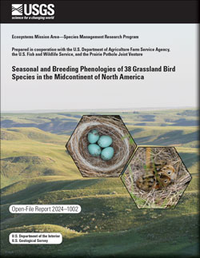Seasonal and Breeding Phenologies of 38 Grassland Bird Species in the Midcontinent of North America
Links
- Document: Report (28.3 MB pdf) , HTML , XML
- Download citation as: RIS | Dublin Core
Acknowledgments
This project was supported by the U.S. Department of Agriculture Farm Service Agency and the U.S. Fish and Wildlife Service. The Prairie Pothole Joint Venture provided critical in-kind support. The authors thank the multitude of citizen scientists, researchers, and authors who collected, vetted, and compiled the avian nesting phenology information into the bird books and breeding bird atlases that formed the backbone of information summarized in this report. We also appreciate the thousands of birders who voluntarily submitted eBird checklists containing one or more of the focal grassland species in the study area, as well as the hundreds of reviewers who volunteered their time to ensure a high level of eBird data quality.
We acknowledge the thoughtful reviews of Brian Tangen (U.S. Geological Survey) and two anonymous reviewers, and we appreciate the guidance provided by Rose Swift (U.S. Geological Survey) during figure design and creation. We also appreciate the support of the U.S. Fish and Wildlife Service Habitat and Population Evaluation Team. The findings and conclusions in this article represent the views of the authors and the U.S. Geological Survey but do not necessarily represent the views of the U.S. Fish and Wildlife Service.
Abstract
Grasslands in the midcontinent of North America are highly imperiled, and grassland birds have suffered the largest bird declines of any terrestrial biome in North America in the last 50 years. Consequently, the conservation and management of grasslands, as well as their associated avian communities, are major priorities for the State, Provincial, and Federal agencies; non-governmental organizations; and private entities that influence the millions of hectares of grasslands in the midcontinent. Resource managers often deploy disturbances to grasslands (for example, grazing, haying, and burning) to maintain or enhance their quality or structure, but the timing of these disturbances has the potential to disrupt the nesting activities of grassland birds. In this report, we compiled two types of phenology information for 38 species of nonwaterfowl, grassland-nesting birds across four author-defined regions in the midcontinent of North America: (1) species- and region-specific arrival and departure dates from the eBird database, which indicate when a species may be assumed to be present in a region; and (2) reported dates of nesting activity for each species (start and end dates of nesting as well as total duration) from published bird distribution and occurrence books and breeding bird atlases, which indicate when nesting by a species may be assumed. This previously available but widely dispersed information, compiled for the first time, will aid resource managers and inform their decisions about the timing of disturbances while minimizing grassland management effects on nesting birds.
Introduction
Grasslands in the midcontinent of North America have been lost or degraded by numerous factors, including agricultural conversion, energy development and other human activities, and invasion by woody vegetation and exotic species, leading to long-term declines in the amount of grassland on the landscape (Bernath-Plaisted and Koper, 2016; Carbutt and others, 2017; Scholtz and Twidwell, 2022). More than 80 percent of the historical extent of grasslands in this region has been converted to other uses since Euro-American settlement (Samson and Knopf, 1994; Niemuth and others, 2022). Remaining grasslands support a large suite of avian species that are undergoing long-term population declines. In North America, grassland birds as a group are declining more than birds that use other habitats (for example, forests, wetlands, and so forth) (Rosenberg and others, 2019). Consequently, an array of State, Provincial, and Federal agencies; non-governmental conservation organizations; and private entities in the North American midcontinent have prioritized the conservation and management of grasslands and their associated bird communities by enacting conservation and management programs that aim to sustain wildlife populations and the habitats they use (Askins and others, 2007; Bernath-Plaisted and others, 2023).
Grassland habitats are periodically managed with disturbance (for example, grazing, haying, and burning) to maintain desired grassland species composition and structure, control noxious weeds and woody vegetation, and provide forage for livestock (Herkert and others, 1996; Askins and others, 2007). However, the annual timing of these practices has the potential to disrupt the nesting activities of grassland birds, which is an especially important concern for birds nesting on conservation program lands. Throughout the midcontinent, land-management agencies strive to use the best available information to time grassland management actions to avoid adversely affecting birds nesting in these habitats (for example, through nest abandonment, destruction of nests, or mortality of chicks or adults). Consequently, information about when grassland birds are actively nesting is needed to inform decisions about the timing of these management actions. Species-specific differences in life-history strategies, abundance or rarity, location and extent of breeding ranges, and other factors have resulted in nesting phenologies that vary greatly among different species of grassland-nesting birds and in different regions of the midcontinent (Johnson and others, 2019). To our knowledge, this phenological information has not been compiled throughout this entire region in a manner that will be useful to wildlife and grassland resource managers.
The purpose of this report is to compile information on the seasonal occurrence (that is, the duration of presence during the annual cycle) and nesting phenology (that is, the time from the first egg laid to the last young fledged from a nest in a region) for 38 species of nonwaterfowl, grassland-nesting birds across a broad swath of the North American grassland biome. We summarize when each species is present in a location, as well as when each species generally nests. The information is organized by taxonomic groups and summarized for broad regions of the midcontinent of North America. Although this published information was sometimes incomplete at the individual State or Provincial level, we provide available information for each focal State and Province in appendix 1. This summarized information can be used by managers who make decisions that balance the health of grassland habitats with the needs of agricultural producers and the birds nesting in these habitats.
Methods
Study Area and Focal Species
The study area encompasses seven Bird Conservation Regions associated with grassland and grassland-sage ecosystems in the midcontinent of North America (fig. 1; North American Bird Conservation Initiative, 2014). This expansive region intersects 18 States and 3 Provinces and represents the approximate extent of the short-, mixed-, and tallgrass prairie ecosystems of North America. This region was historically dominated by grassland land cover, but currently most of it has been converted for agricultural land uses, especially in grasslands in the eastern portion of this region (Samson and Knopf, 1994; Niemuth and others, 2022).
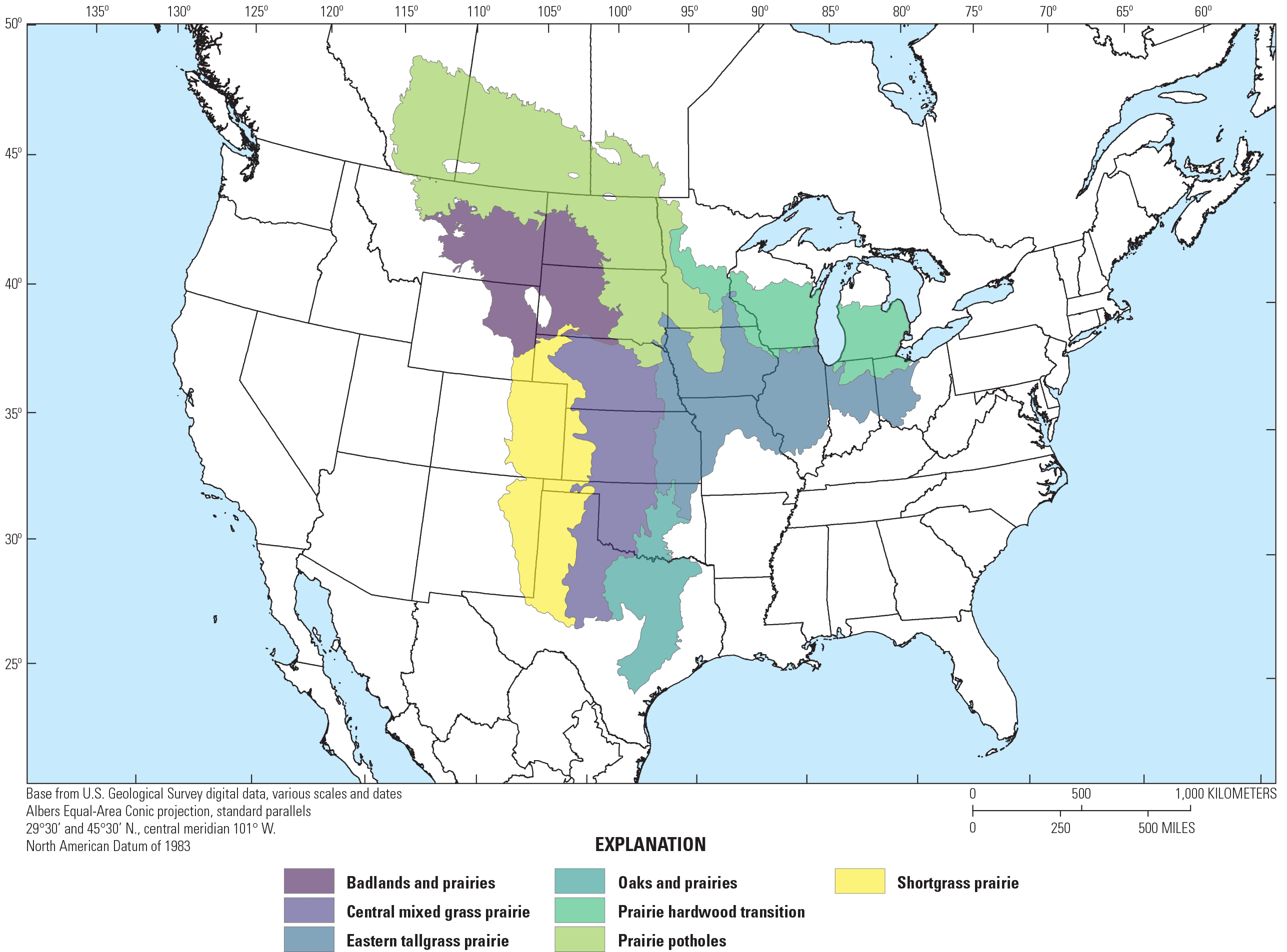
Project study area in the midcontinent of North America consisting of seven Bird Conservation Regions (North American Bird Conservation Initiative, 2014) associated with grassland ecosystems.
We selected a suite of 38 nonwaterfowl bird species representing five taxonomic groups (that is, upland gamebirds, shorebirds, herons, raptors and owls, and passerines) that nest in grassland habitats in the midcontinent (table 1); waterfowl were excluded because they are being addressed in a companion study. The list of species is representative of the broad range of grassland habitats present in the midcontinent of North America, and it was informed by the species included in Johnson and others (2019), with a few modifications. The list includes obligate grassland birds (that is, species that are exclusively adapted to and entirely dependent on grassland habitats) and facultative grassland birds (that is, species that use grasslands as part of a wider array of habitats) (Vickery and others, 1999). Although the focus in this report is to inform habitat management decisions for a diverse assemblage of grassland bird species, there is considerable variation in the population status and conservation attention among the focal species (Fields, 2017; Sauer and others, 2020). Additionally, these species vary widely in life-history characteristics that could affect the phenology of their nesting (Winter and others, 2004; Jones and others, 2010), such as affinities for specific habitat structures (Perlut and others, 2006; Churchwell and others, 2008), precocial versus altricial chick development, migration distance or year-round residency, and the propensity to renest or attempt multiple broods (Lloyd and Martin, 2005).
Table 1.
Alpha codes, common and scientific names, and taxonomic group membership of 38 focal grassland bird species nesting in the midcontinent of North America. Vernacular and scientific names follow Chesser and others (2023), and species are listed in taxonomic order.Review of Phenology Information
We searched more than 50 sources of compiled avian phenology information (that is, published books and breeding bird atlases containing information on avian distribution and occurrence; appendix 2), as well as the eBird database, an online citizen-science database of global bird observations (Sullivan and others, 2009). From those sources, the following information was compiled for each of the 38 focal species in each of four author-defined regions in the midcontinent of North America (fig. 2): (1) species- and region-specific arrival and departure dates from the eBird database (that is, “seasonal occurrence”), and (2) species- and region-specific reported start and end dates of nesting activity and the duration of the nesting period (that is, “nesting phenology”).
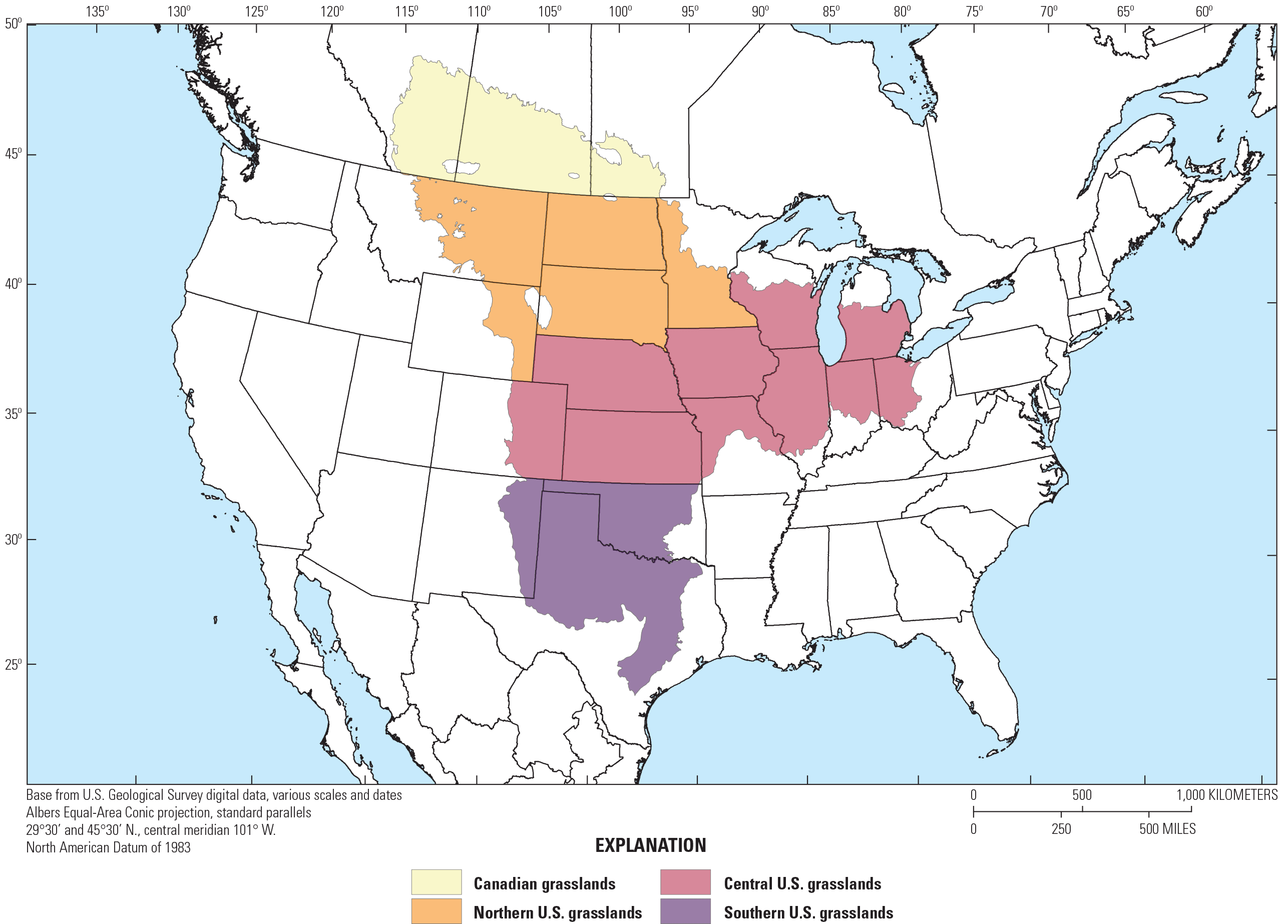
The four author-defined regions used to summarize seasonal occurrence and nesting phenology information for 38 species of nonwaterfowl grassland birds in the midcontinent of North America.
For seasonal occurrence information, we accessed line graphs of frequency from the eBird database (eBird, 2023; that is, the frequency with which a species was reported to eBird within a region, measured by the percent of eBird checklists reporting the species during each week of the year) for each of the 38 species in our regions of interest. We considered eBird data from the past 50 years (that is, 1973–2023), because these five decades approximated the period of most of the nesting phenology information. We visually assessed and disregarded extreme outliers in the data. For migratory species, we assessed the graphs and recorded the approximate date (that is, the week) that a species arrived on its breeding grounds and the week that a species departed its breeding grounds for each region. A species was recorded as being a year-round resident (that is, nonmigratory) in a region if the eBird frequency graph did not show distinct periods of arrival and departure. An example for a migratory species, the Baird’s sparrow [Centronyx bairdii], in North Dakota, is shown in figure 3. In this example, the species’ arrival and departure dates in North Dakota, respectively, were recorded as May 1 and August 31.
For nesting phenology information, we reviewed available books and breeding bird atlases, including some sources that were available only online, for the 18 States and 3 Provinces in the study area. Books and atlases were searched for information on nesting phenology; such information often included extreme nesting dates (beginning and end dates), egg dates (dates when nests with eggs have been known to occur), as well as qualitative statements by the author(s) about when the species is likely to be nesting based on the authors’ experiences or based on unknown sources. Occasionally, publications summarized rigorously collected information from a breeding bird atlas (for example, they provided histograms of nesting dates for nests that were reported by atlas observers). All information available in these books and atlases was compiled. In some cases, exact dates were provided (for example, “May 16 to July 14”). Other times, the information was less precise (for example, “mid-May to mid-July”) or the information was presented in a histogram or other graphic presentation. In the latter situation, we summarized the information using common decision rules to aggregate information at the level of the week (for example, “first week of May” became May 1, “mid-May” became May 15, and “third week of May” became May 22). Sources of phenology information were based on the entire State or Province, rather than just the grassland portions illustrated by the study area boundary in figure 2.
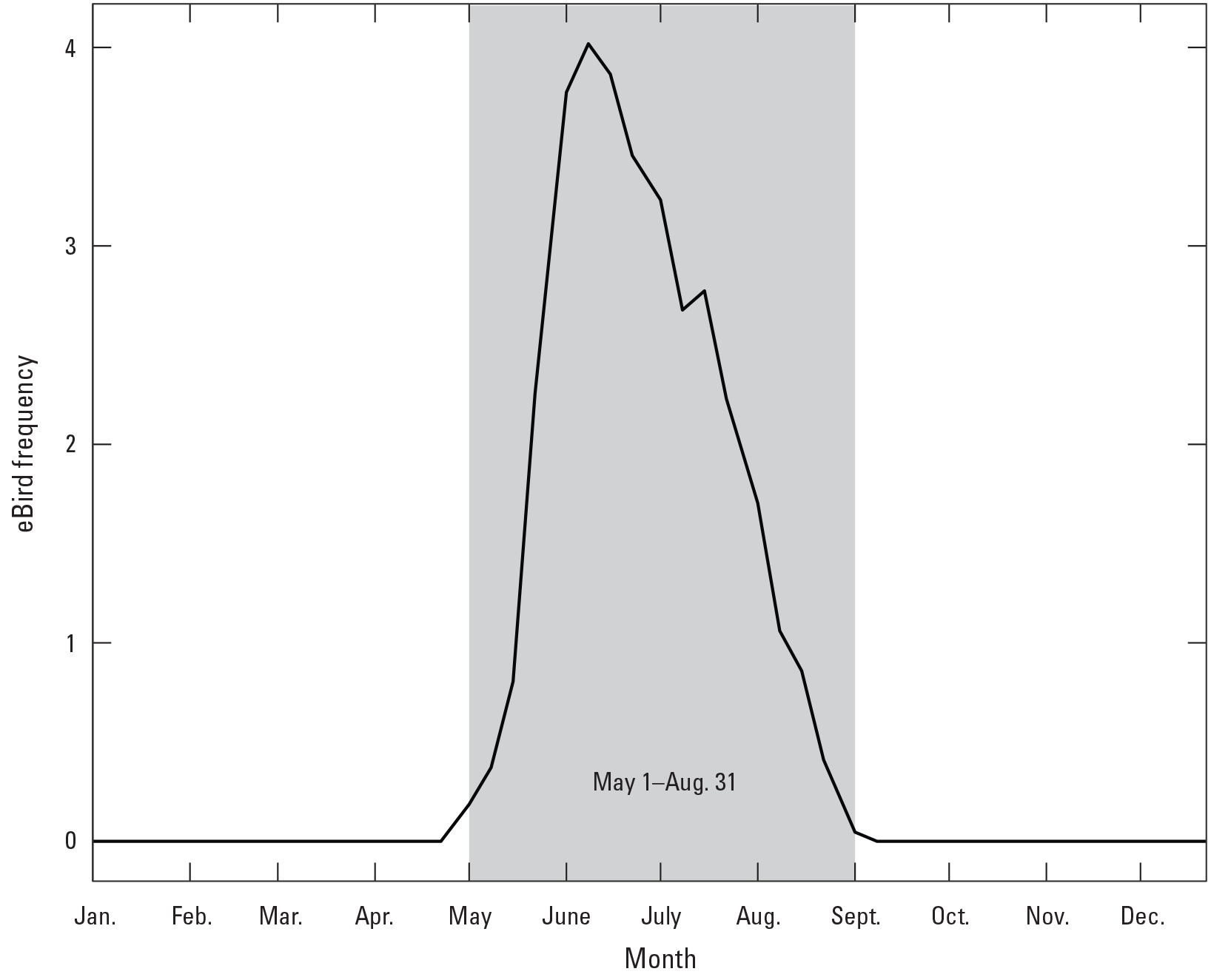
eBird frequency for Baird’s sparrow (Centronyx bairdii) in North Dakota with the species’ arrival and departure dates (May 1 and August 31, respectively) used in this report (eBird, 2023).
Overall, published nesting phenology information was located for 19 of the 21 States and Provinces in the study area: Alberta, Saskatchewan, Manitoba, Montana, North Dakota, South Dakota, Minnesota, Colorado, Nebraska, Kansas, Iowa, Missouri, Wisconsin, Illinois, Indiana, Ohio, Michigan, Oklahoma, and Texas. We lacked nesting phenology information for New Mexico and Wyoming. In the case of New Mexico, the book written on the State’s birdlife (Bailey, 1928) contained no nesting phenology information, and a breeding bird atlas from the early 2000s was not completed (Dave Krueper, U.S. Fish and Wildlife Service, retired, written commun., 2023). In the case of Wyoming, two books have been written about the State’s birdlife (Knight, 1902; Faulkner, 2010), but neither contained nesting phenology information. A formal breeding bird atlas also has not been published for Wyoming.
Because not all States and Provinces had nesting phenology information, we aggregated information into four larger regions that were defined based on similarities in latitude, comparable species-specific arrival and departure dates from the eBird database, and personal knowledge of avian phenology in each location. The four regions were defined as Canadian grasslands (Alberta, Saskatchewan, and Manitoba), northern U.S. grasslands (Montana, North Dakota, South Dakota, Wyoming, and Minnesota), central U.S. grasslands (Nebraska, Colorado, Kansas, Iowa, Missouri, Wisconsin, Illinois, Michigan, Indiana, and Ohio), and southern U.S. grasslands (New Mexico, Oklahoma, and Texas) (fig. 2). We compiled existing phenology information for the constituent States or Provinces in a region and calculated the median dates for the start and end of nesting, which are the dates reported in the figures.
Results and Discussion
In this report, two types of phenology information (that is, seasonal occurrence and nesting phenology) are summarized for four regions consisting of 18 States and 3 Provinces in the North American midcontinent (figs. 4–7; table 2). The phenology information available at the level of the individual State or Province is also summarized and is provided in appendix 1 (figs. 1.1–1.21). These summaries provide information about relative differences in timing and duration of a species’ occurrence in a region as well as when a species is likely to be nesting. This information will help resource managers better understand when grassland species are likely to be present and nesting in the grasslands they manage throughout the midcontinent.
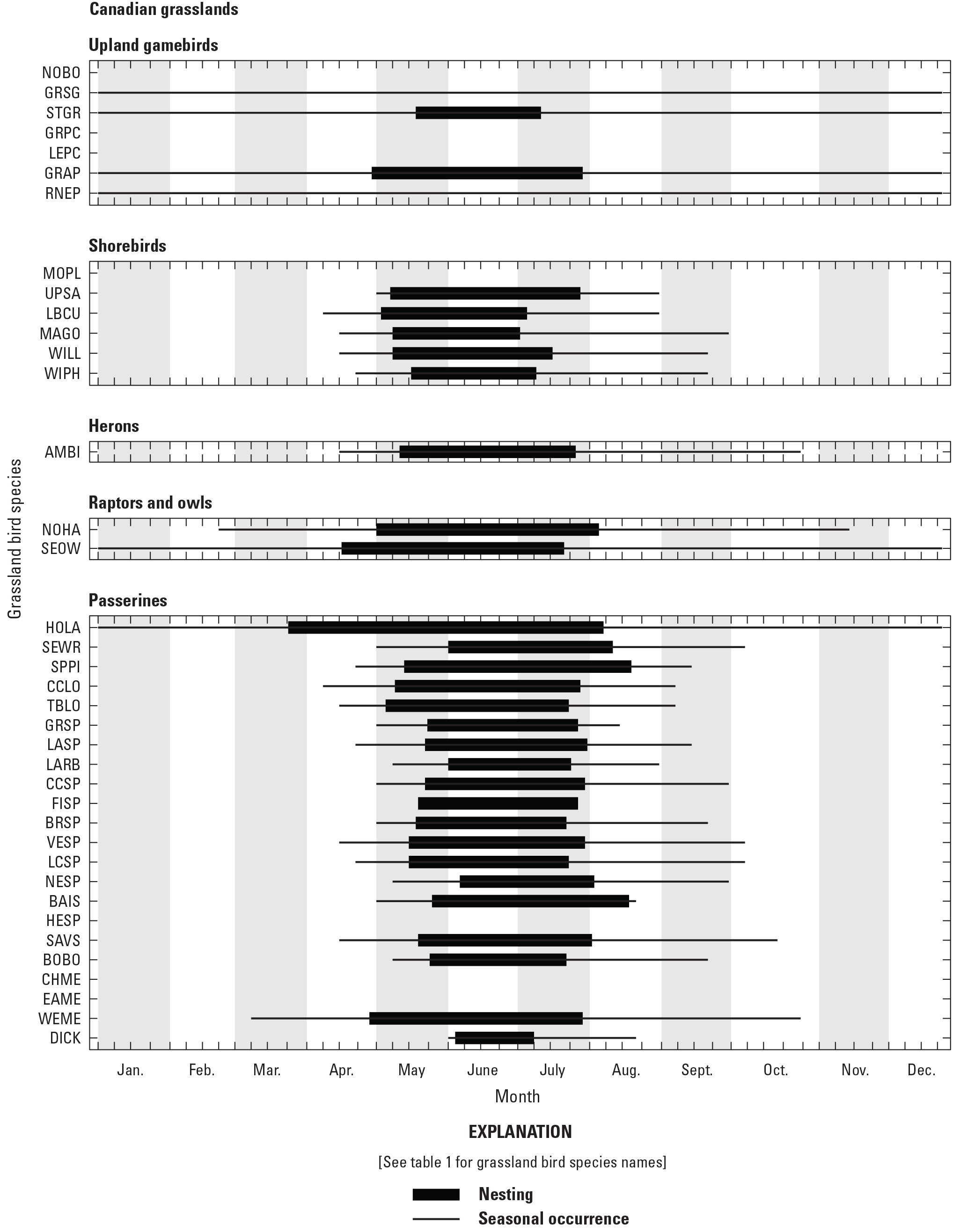
Seasonal occurrence and nesting phenology information for 38 species of grassland birds in the Canadian grasslands (Manitoba Avian Research Committee, 2003; Rousseu and Drolet, 2015; eBird, 2023).
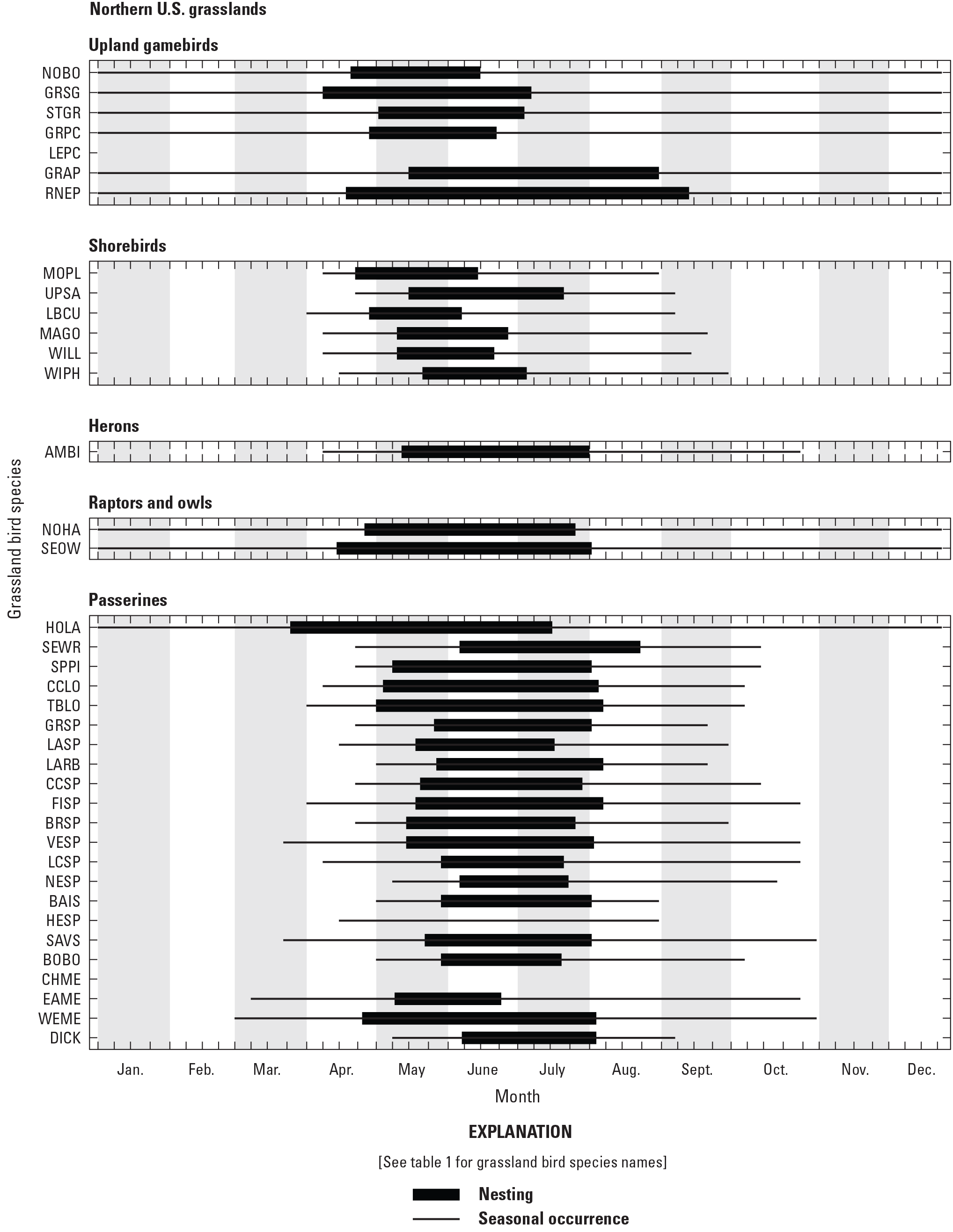
Seasonal occurrence and nesting phenology information for 38 species of grassland birds in the northern U.S. grasslands (Roberts, 1932a, b45; Stewart, 1975; Whitney, 1978; South Dakota Ornithologists’ Union, 1991; Peterson, 1995; Tallman and others, 2002; Marks and others, 2016; eBird, 2023).
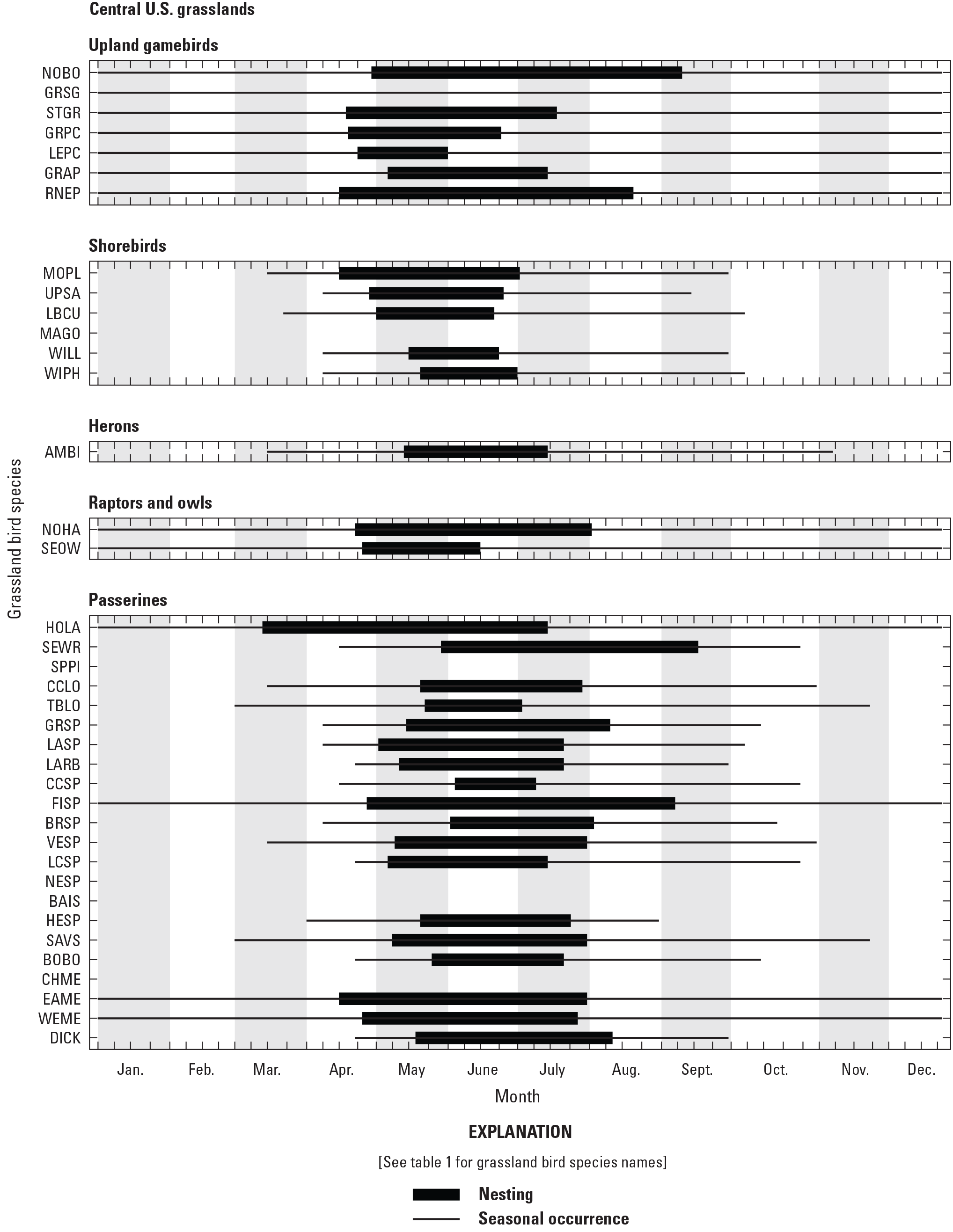
Seasonal occurrence and nesting phenology information for 38 species of grassland birds in the central U.S. grasslands (Johnston, 1965; Dinsmore and others, 1984; Mumford and Keller, 1984; Bohlen, 1989; Thompson and Ely, 1989; Brewer and others, 1991; Robbins, 1991; Thompson and Ely, 1992; Granlund and McPeek, 1994; Jackson and others, 1996; Jacobs and Wilson, 1997; Kingery, 1998; Peterjohn, 2001; Cutright and others, 2006; Thompson and others, 2011; Chartier and others, 2013; Mollhoff, 2022; eBird, 2023).
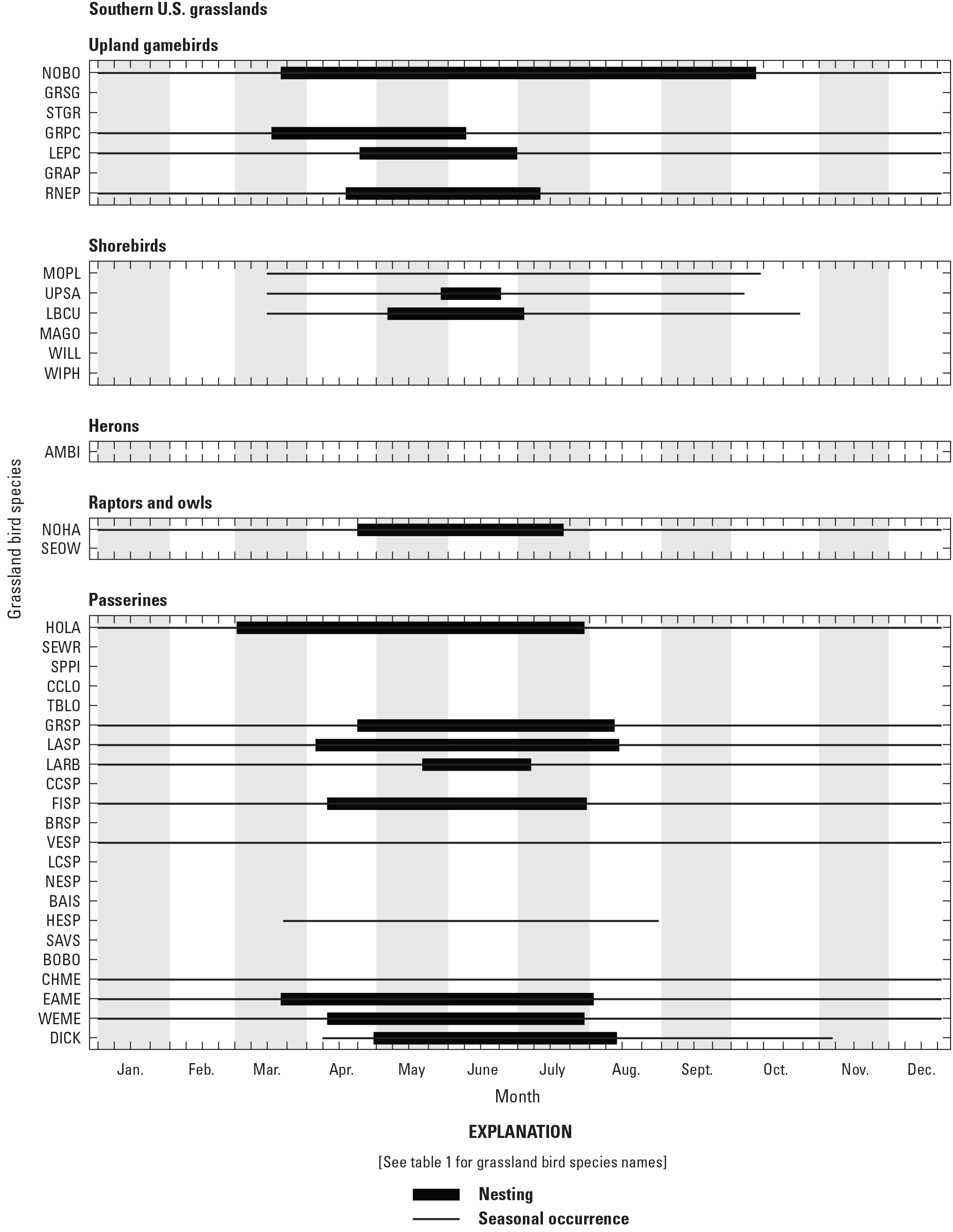
Seasonal occurrence and nesting phenology information for 38 species of grassland birds in the southern U.S. grasslands (Oberholser, 1932; Baumgartner and Baumgartner, 1992; Benson and Arnold, 2001; eBird, 2023).
Table 2.
Maximum published nesting dates and nesting durations for 38 species of nonwaterfowl grassland birds in four author-defined regions in the midcontinent of North America. Species are organized by taxonomic group, and species listed are in taxonomic order (Chesser and others, 2023).[No., number; --, no data]
| Alpha code (table 1) |
Canadian grasslands | Northern U.S. grasslands | Central U.S. grasslands | Southern U.S. grasslands | |||||
|---|---|---|---|---|---|---|---|---|---|
| Nesting range | No. days | Nesting range | No. days | Nesting range | No. days | Nesting range | No. days | ||
| NOBO | -- | -- | April 20–June 15 | 56 | April 29–September 10 | 134 | March 21–October 12 | 205 | |
| GRSG | -- | -- | April 8–July 7 | 90 | -- | -- | -- | -- | |
| STGR | May 18–July 11 | 54 | May 2–July 4 | 63 | April 18–July 18 | 91 | -- | -- | |
| GRPC | -- | -- | April 28–June 22 | 55 | April 19–June 24 | 66 | March 17–June 9 | 84 | |
| LEPC | -- | -- | -- | -- | April 23–June 1 | 39 | April 24–July 1 | 68 | |
| GRAP | April 29–July 29 | 91 | May 15–August 31 | 108 | May 6–July 14 | 69 | -- | -- | |
| RNEP | -- | -- | April 18–September 13 | 148 | April 15–August 20 | 127 | April 18–July 11 | 84 | |
| MOPL | -- | -- | April 22–June 14 | 53 | April 15–July 2 | 78 | -- | -- | |
| UPSA | May 7–July 28 | 82 | May 15–July 21 | 67 | April 28–June 25 | 58 | May 29–June 24 | 26 | |
| LBCU | May 3–July 5 | 63 | April 28–June 7 | 40 | May 1–June 21 | 51 | May 6–July 4 | 59 | |
| MAGO | May 8–July 2 | 55 | May 10–June 27 | 48 | -- | -- | -- | -- | |
| WILL | May 8–July 16 | 69 | May 10–June 21 | 42 | May 15–June 23 | 39 | -- | -- | |
| WIPH | May 16–July 9 | 54 | May 21–July 5 | 45 | May 20–July 1 | 42 | -- | -- | |
| AMBI | May 11–July 26 | 76 | May 12–August 1 | 81 | May 13–July 14 | 62 | -- | -- | |
| NOHA | May 1–August 5 | 96 | April 26–July 26 | 91 | April 22–August 2 | 102 | April 23–July 21 | 89 | |
| SEOW | April 16–July 21 | 96 | April 14–August 2 | 110 | April 25–June 15 | 51 | -- | -- | |
| HOLA | March 24-August 7 | 136 | March 25–July 16 | 113 | March 13–July 14 | 123 | March 2–July 30 | 150 | |
| SEWR | June 1–August 11 | 71 | June 6–August 23 | 78 | May 29–September 17 | 111 | -- | -- | |
| SPPI | May 13-–August 19 | 98 | May 8–August 2 | 86 | -- | -- | -- | -- | |
| CCLO | May 9–July 28 | 80 | May 4–August 5 | 93 | May 20–July 29 | 70 | -- | -- | |
| TBLO | May 5–July 23 | 79 | May 1–August 7 | 98 | May 22–July 3 | 42 | -- | -- | |
| GRSP | May 23–July 27 | 65 | May 26–August 2 | 68 | May 14–August 10 | 88 | April 23–August 12 | 111 | |
| LASP | May 22–July 31 | 70 | May 18–July 17 | 60 | May 2–July 21 | 80 | April 5–August 14 | 131 | |
| LARB | June 1–July 24 | 53 | May 27–August 7 | 72 | May 11–July 21 | 71 | May 21–July 7 | 47 | |
| CCSP | May 22–July 30 | 69 | May 20–July 29 | 70 | June 4–July 9 | 35 | -- | -- | |
| FISP | May 19–July 27 | 69 | May 18–August 7 | 81 | April 27–September 7 | 133 | April 10–July 31 | 112 | |
| BRSP | May 18–July 22 | 65 | May 14–July 26 | 73 | June 2–August 3 | 62 | -- | -- | |
| VESP | May 15–July 30 | 76 | May 14–August 3 | 81 | May 9–July 31 | 83 | -- | -- | |
| LCSP | May 15–July 23 | 69 | May 29–July 21 | 53 | May 6–July 14 | 69 | -- | -- | |
| NESP | June 6–August 3 | 58 | June 6–July 23 | 47 | -- | -- | -- | -- | |
| BAIS | May 25–August 18 | 85 | May 29–August 2 | 65 | -- | -- | -- | -- | |
| HESP | -- | -- | -- | -- | May 20–July 24 | 65 | -- | -- | |
| SAVS | May 19–August 2 | 75 | May 22- August 2 | 72 | May 8–July 31 | 84 | -- | -- | |
| BOBO | May 24–July 22 | 59 | May 29–July 20 | 52 | May 25–July 21 | 57 | -- | -- | |
| CHME | -- | -- | -- | -- | -- | -- | -- | -- | |
| EAME | -- | -- | May 9–June 24 | 46 | April 15–July 31 | 107 | March 21–August 3 | 135 | |
| WEME | April 28–July 29 | 92 | April 25–August 4 | 101 | April 25–July 27 | 93 | April 10–July 30 | 111 | |
| DICK | June 4–July 8 | 34 | June 7–August 4 | 58 | May 18–August 11 | 85 | April 30–August 13 | 105 | |
The published nesting dates and nesting durations for the 38 species of nonwaterfowl grassland birds in the four regions in the midcontinent are summarized in table 2. For all species combined in a region, the total nesting durations were 149 days (March 24 to August 19) for Canadian grasslands, 173 days (March 25 to September 13) for northern U.S. grasslands, 189 days (March 13 to September 17) for central U.S. grasslands, and 164 days (March 2 to August 12 for southern U.S. grasslands. These dates extend beyond and comprise longer durations than those of the primary nesting seasons set by the U.S. Department of Agriculture to avoid disturbance to nesting cover and nesting birds in grasslands enrolled in the Conservation Reserve Program (Farm Service Agency, 2020), but it is important to note that the current primary nesting season dates for individual States are based on the species selected by the State technical committees of the U.S. Department of Agriculture. Nesting dates reported here, however, can be interpreted as likely minimum and maximum nesting dates. Information is currently lacking to estimate the proportion of active nests throughout the breeding season, which could help managers evaluate tradeoffs in timing of grassland managements actions.
Compiling this information provided a unique opportunity to examine patterns in nesting phenology across species and guilds. In general, native upland gamebirds (northern bobwhite [Colinus virginianus], sharp-tailed grouse [Tympanuchus phasianellus], greater prairie-chicken [Tympanuchus cupido], lesser prairie-chicken [Tympanuchus pallidicinctus]) tended to begin nesting later and (or) had shorter nesting durations in northern areas compared to southern areas. The ring-necked pheasant (Phasianus colchicus), a non-native upland gamebird, begins nesting in mid-April throughout its range in the United States but shows an opposite pattern to its native counterparts, with a longer nesting duration in northern areas than in southern areas. Most shorebirds show a different pattern from those exhibited by native upland gamebirds. Upland sandpiper (Bartramia longicauda), marbled godwit (Limosa fedoa), willet (Tringa semipalmata), and Wilson’s phalarope (Phalaropus tricolor) tended to begin nesting earlier and (or) had longer nesting durations in northern areas than in southern areas. There were few noteworthy patterns for passerines. The eastern meadowlark (Sturnella magna) and dickcissel (Spiza americana) tended to begin nesting later and (or) had shorter nesting durations in northern areas compared to southern areas, which is similar to the pattern shown for native upland gamebirds. For some passerine species (for example, vesper sparrow [Pooecetes gramineus], Savannah sparrow [Passerculus sandwichensis], and bobolink [Dolichonyx oryzivorus]), it was noteworthy that the beginning of their nesting seasons and their nesting durations were consistent in all regions in which the species were present (table 2). Patterns between or among species in this report could be coupled with results from Anteau and others (2023) to help managers make species- or guild-oriented management decisions.
The amount and type of nesting phenology information from the above publications varied tremendously. For example, some authors summarized information rigorously collected by citizen scientists and researchers as part of an official breeding bird atlas (for example, Kingery, 1998). Such information often was presented in the form of histograms of nesting activity. Also commonly reported were start and end dates of nesting or a list of dates when nests or nests with eggs were discovered (for example, Stewart, 1975). Even when such information was reported, the number of nests present for each species with phenology information was often limited (less than 30 nests in a single year or during 2–3 years). However, most of the nesting phenology information was coarser, consisting of qualitative statements by the author(s) that reflected expert opinion or unknown sources.
Figures presented in this report that summarize phenology information should be interpreted and used with caution for several reasons. First, the amount and level of detail on phenology provided in the published literature varied among sources. The data in some sources were collected with rigor (for example, breeding bird atlases), whereas data in other sources represented estimates from unknown sources or opinions of the expert(s) that authored the species account(s). Expert estimates or opinions can be affected by information available at the time of publication or the individual experiences of the author(s), which could be subject to bias. Second, some of the published information in books and breeding bird atlases was collected or published decades ago, and the breeding phenology of certain species of North American birds may have changed over time with land use and land cover change, climate change (Knudsen and others, 2011), and shifts in breeding ranges (Langham and others, 2015). Third, apparent trends in spring arrival or fall departures dates, start or end of nesting, and nesting duration may be artifacts of the information that was reported in the books and atlases (that is, the lack of data in some locations and the varying level of precision in how dates were reported) rather than representative of precise biological patterns. This is true even for the seasonal occurrence data from eBird. Fourth, the published nesting phenology information includes only those dates a nest was determined to be active and may not be wholly representative of a species’ entire nesting season or when young may be vulnerable outside of a nest. And finally, phenology can vary considerably within or among a region, State, or Province based on local climatic conditions, elevation, and many other factors (Anteau and others, 2023).
This project revealed notable gaps in the understanding of avian phenology in the grasslands of the midcontinent of North America and the need for better reporting and data availability of nest phenology information by researchers. Given that much of the available nesting phenology information was published decades ago and that the timing of nesting and migration may have changed for some species (for example, Bates and others, 2023), updating this information at State and Provincial levels would be prudent, especially considering a changing climate (Langham and others, 2015). Additionally, the available nesting information defined nesting as ending when young leave the nest bowl, but that definition misses a critical window of vulnerability for many bird species in which the young are still dependent on parental care and may have home ranges that extend well beyond the adults’ breeding territory. For example, Suedkamp Wells (2005) reported that postfledging resource use differed from adult resource use for dickcissels and eastern meadowlarks. There is growing interest in developing realistic guidelines for grassland management that incorporate adult and juvenile life-history needs on public and private lands (for example, Suedkamp Wells and others, 2008; Wolcott and others, 2023). The lack of information in the literature on the duration of the postfledging period, as well as minimum area requirements of fledglings for most grassland bird species, is an important gap that should be considered when making decisions about the timing of management actions in grasslands.
Despite the above limitations, this report unifies and summarizes disparate sources of nesting phenology information for many grassland-nesting bird species of the North American midcontinent for the first time and provides resource managers with a single source of the best currently available information (as of 2023) about the timing and duration of the nesting period. We encourage grassland bird researchers to collect and make available nesting data that would improve the understanding of nesting phenology for grassland birds in the midcontinent.
References Cited
Anteau, M.J., Ellis, K.S., MacDonald, G.J., Igl, L.D., Niemuth, N.D., and Vest, J.L., 2023, Climate-induced shifts in grassland bird nesting phenology have implications for grassland management: Global Ecology and Conservation, v. 48, e02700. [Also available at https://doi.org/10.1016/j.gecco.2023.e02700.]
Askins, R.A., Chávez-Ramírez, F., Dale, B.C., Haas, C.A., Herkert, J.R., Knopf, F.L., and Vickery, P.D., 2007, Conservation of grassland birds in North America—Understanding ecological processes in different regions: Ornithological Monographs, No. 64, p. 1–46. [Also available at https://doi.org/10.2307/40166905.]
Bates, J.M., Fidino, M., Nowak-Boyd, L., Strausberger, B.M., Schmidt, K.A., and Whelan, C.J., 2023, Climate change affects bird nesting phenology—Comparing contemporary field and historical museum nesting records: Journal of Animal Ecology, v. 92, no. 2, p. 263–272. [Also available at https://doi.org/10.1111/1365-2656.13683.]
Benson, K.L.P., and Arnold, K.A., 2001, The Texas Breeding Bird Atlas: College Station and Corpus Christi, Tex., Texas A&M University System, accessed July 15, 2023, at https://txtbba.tamu.edu/.
Bernath-Plaisted, J.S., Correll, M.D., Somershoe, S.G., Dwyer, A.M., Bankert, A., Beh, A., Berlanga, H., Boyle, W.A., Cruz-Romo, J.L., George, T.L., Herkert, J., Koper, N., Macías-Duarte, A., Panjabi, A.O., Ramírez-Flores, O.M., Robinson, B., Ruvalcaba-Ortega, I., Sibbin, J., Strasser, E.H., Titulaer, M., Van Pelt, W.E., and VerCauteren, T., 2023, Review of conservation challenges and possible solutions for grassland birds of the North American Great Plains: Rangeland Ecology and Management, v. 90, p. 165–185. [Also available at https://doi.org/10.1016/j.rama.2023.07.002.]
Bernath-Plaisted, J., and Koper, N., 2016, Physical footprint of oil and gas infrastructure, not anthropogenic noise, reduces nesting success of some grassland songbirds: Biological Conservation, v. 204, part B, p. 434–441. [Also available at https://doi.org/10.1016/j.biocon.2016.11.002.]
Carbutt, C., Henwood, W.D., and Gilfedder, L.A., 2017, Global plight of native temperate grasslands—Going, going, gone?: Biodiversity and Conservation, v. 26, no. 12, p. 2911–2932. [Also available at https://doi.org/10.1007/s10531-017-1398-5.]
Chartier, A.T., Baldy, J.J., and Brenneman, J., eds., 2013, The second Michigan Breeding Bird Atlas, 2002–2008: Kalamazoo, Mich., Kalamazoo Nature Center, 623 p., accessed August 18, 2023, at https://naturecenter.org/wp-content/uploads/2022/05/MBBA-BOOK2.pdf.
Chesser, R.T., Billerman, S.M., Burns, K.J., Cicero, C., Dunn, J.L., Hernández-Baños, B.E., Jiménez, R.A., Kratter, A.W., Mason, N.A., Rasmussen, P.C., Remsen, J.V., Jr., and Winker, K., 2023, Checklist of North and Middle American birds: American Ornithological Society, accessed September 25, 2023, at https://checklist.americanornithology.org/taxa/.
Churchwell, R.T., Davis, C.A., Fuhlendorf, S.D., and Engle, D.M., 2008, Effects of patch-burn management on Dickcissel nest success in a tallgrass prairie: The Journal of Wildlife Management, v. 72, no. 7, p. 1596–1604. [Also available at https://doi.org/10.2193/2007-365.]
eBird, 2023, eBird—An online database of bird distribution and abundance: Ithaca, N.Y., Cornell Lab of Ornithology database, accessed July 15, 2023, at https://www.ebird.org.
Farm Service Agency, 2020, Primary nesting season dates and duration: Washington, D.C., U.S. Department of Agriculture, Farm Service Agency, 1 p. [Also available at https://www.fsa.usda.gov/Assets/USDA-FSA-Public/usdafiles/Conservation/PDF/Primary%20Nesting%20Season_June_16_2020.pdf.]
Fields, S.P., ed., 2017, 2017 Prairie Pothole Joint Venture Implementation Plan: Denver, Colo., U.S. Fish and Wildlife Service, 63 p., accessed July 15, 2023, at https://ppjv.org/resources/.
Herkert, J.R., Sample, D.W., and Warner, R.E., 1996, Management of midwestern grassland landscapes for the conservation of migratory birds, in Thompson, F.R. III, ed., Management of midwestern landscapes for the conservation of Neotropical migratory birds: St. Paul, Minn., U.S. Forest Service, North Central Forest Experiment Station, p. 89–116.
Johnson, D.H., Igl, L.D., Shaffer, J.A., and DeLong, J.P., eds., 2019, The effects of management practices on grassland birds (ver. 1.2, June 2023): U.S. Geological Survey Professional Paper 1842. [Also available at https://doi.org/10.3133/pp1842.]
Jones, S.L., Dieni, J.S., and Gouse, P.J., 2010, Reproductive biology of a grassland songbird community in northcentral Montana: The Wilson Journal of Ornithology, v. 122, no. 3, p. 455–464. [Also available at https://doi.org/10.1676/08-171.1.]
Knight, W.C., 1902, The birds of Wyoming: Laramie, Wyo., University of Wyoming, 174 p. [Also available at https://doi.org/10.5962/bhl.title.53932.]
Knudsen, E., Lindén, A., Both, C., Jonzén, N., Pulido, F., Saino, N., Sutherland, W.J., Bach, L.A., Coppack, T., Ergon, T., Gienapp, P., Gill, J.A., Gordo, O., Hedenström, A., Lehikoinen, E., Marra, P.P., Møller, A.P., Kilsson, A.L.K., Péron, G., Ranta, E., Rubolini, D., Sparks, T.H., Spina, F., Studds, C.E., Sæther, S.A., Tryjanowski, P., and Stenseth, N.C., 2011, Challenging claims in the study of migratory birds and climate change: Biological Reviews of the Cambridge Philosophical Society, v. 86, no. 4, p. 928–946. [Also available at https://doi.org/10.1111/j.1469-185X.2011.00179.x.]
Langham, G.M., Schuetz, J.G., Distler, T., Soykan, C.U., and Wilsey, C., 2015, Conservation status of North American birds in the face of future climate change: PLoS One, v. 10, no. 9, e0135350. [Also available at https://doi.org/10.1371/journal.pone.0135350.]
Lloyd, J.D., and Martin, T.E., 2005, Reproductive success of Chestnut-collared Longspurs in native and exotic grassland: The Condor, v. 107, no. 2, p. 363–374. [Also available at https://doi.org/10.1093/condor/107.2.363.]
Mollhoff, W.J., 2022, Nest records of Nebraska birds: Lincoln, Nebr., University of Nebraska-Lincoln Libraries, 111 p. [Also available at https://doi.org/10.32873/unl.dc.zea.1318.]
Niemuth, N.D., Barnes, K.W., Tack, J.D., and Iovanna, R., 2022, Past is prologue—Historic landcover patterns predict contemporary grassland loss in the U.S. Northern Great Plains: Landscape Ecology, v. 37, no. 12, p. 3011–3027. [Also available at https://doi.org/10.1007/s10980-022-01528-3.]
North American Bird Conservation Initiative, 2014, NABCI Bird Conservation Regions: Published by Bird Studies Canada on behalf of the North American Bird Conservation Initiative, accessed July 15, 2023, at https://www.birdscanada.org/bird-science/nabci-bird-conservation-regions.
Perlut, N.G., Strong, A.M., Donovan, T.M., and Buckley, N.J., 2006, Grassland songbirds in a dynamic management landscape—Behavioral responses and management strategies: Ecological Applications, v. 16, no. 6, p. 2235–2247. [Also available at https://doi.org/10.1890/1051-0761(2006)016[2235:GSIADM]2.0.CO;2.]
Rosenberg, K.V., Dokter, A.M., Blancher, P.J., Sauer, J.R., Smith, A.C., Smith, P.A., Stanton, J.C., Panjabi, A., Helft, L., Parr, M., and Marra, P.P., 2019, Decline of the North American avifauna: Science, v. 366, no. 6461, p. 120–124. [Also available at https://doi.org/10.1126/science.aaw1313.]
Rousseu, F., and Drolet, B., 2015, Prediction of the nesting phenology of birds in Canada, in Hussell, J., and Lepage, D., eds., Nesting calendar query tool—Project NestWatch: Port Rowan, Ontario, Bird Studies Canada, accessed August 25, 2023, at https://naturecounts.ca/apps/rnest/index.jsp.
Samson, F., and Knopf, F., 1994, Prairie conservation in North America: BioScience, v. 44, no. 6, p. 418–421. [Also available at https://doi.org/10.2307/1312365.]
Sauer, J.R., Link, W.A., and Hines, J.E., 2020, The North American Breeding Bird Survey, analysis results 1966–2019: U.S. Geological Survey data release, accessed July 15, 2023, at https://doi.org/10.5066/P96A7675.
Scholtz, R., and Twidwell, D., 2022, The last continuous grasslands on Earth—Identification and conservation importance: Conservation Science and Practice, v. 4, no. 3, e626. [Also available at https://doi.org/10.1111/csp2.626.]
Suedkamp Wells, K.M., Millspaugh, J.J., Ryan, M.R., and Hubbard, M.W., 2008, Factors affecting home range size and movements of post-fledging grassland birds: The Wilson Journal of Ornithology, v. 120, no. 1, p. 120–130. [Also available at https://doi.org/10.1676/06-117.1.]
Sullivan, B.L., Wood, C.L., Iliff, M.J., Bonney, R.E., Fink, D., and Kelling, S., 2009, eBird—A citizen-based bird observation network in the biological sciences: Biological Conservation, v. 142, no. 10, p. 2282–2292. [Also available at https://doi.org/10.1016/j.biocon.2009.05.006.]
Winter, M., Johnson, D.H., Shaffer, J.A., and Svedarsky, W.D., 2004, Nesting biology of three grassland passerines in the northern tallgrass prairie: The Wilson Bulletin, v. 116, no. 3, p. 211–223. [Also available at https://doi.org/10.1676/03-082.]
Wolcott, D.M., Herkert, J.R., Ribic, C.A., Renfrew, R.B., and Sample, D.W., 2023, Potential impacts of land-management schedules on grassland bird nests and fledglings: Wildlife Society Bulletin, e1488, 13 p. [Also available at https://doi.org/10.1002/wsb.1488.]
Appendix 1. State- and Province-Level Summaries of Grassland Bird Phenology
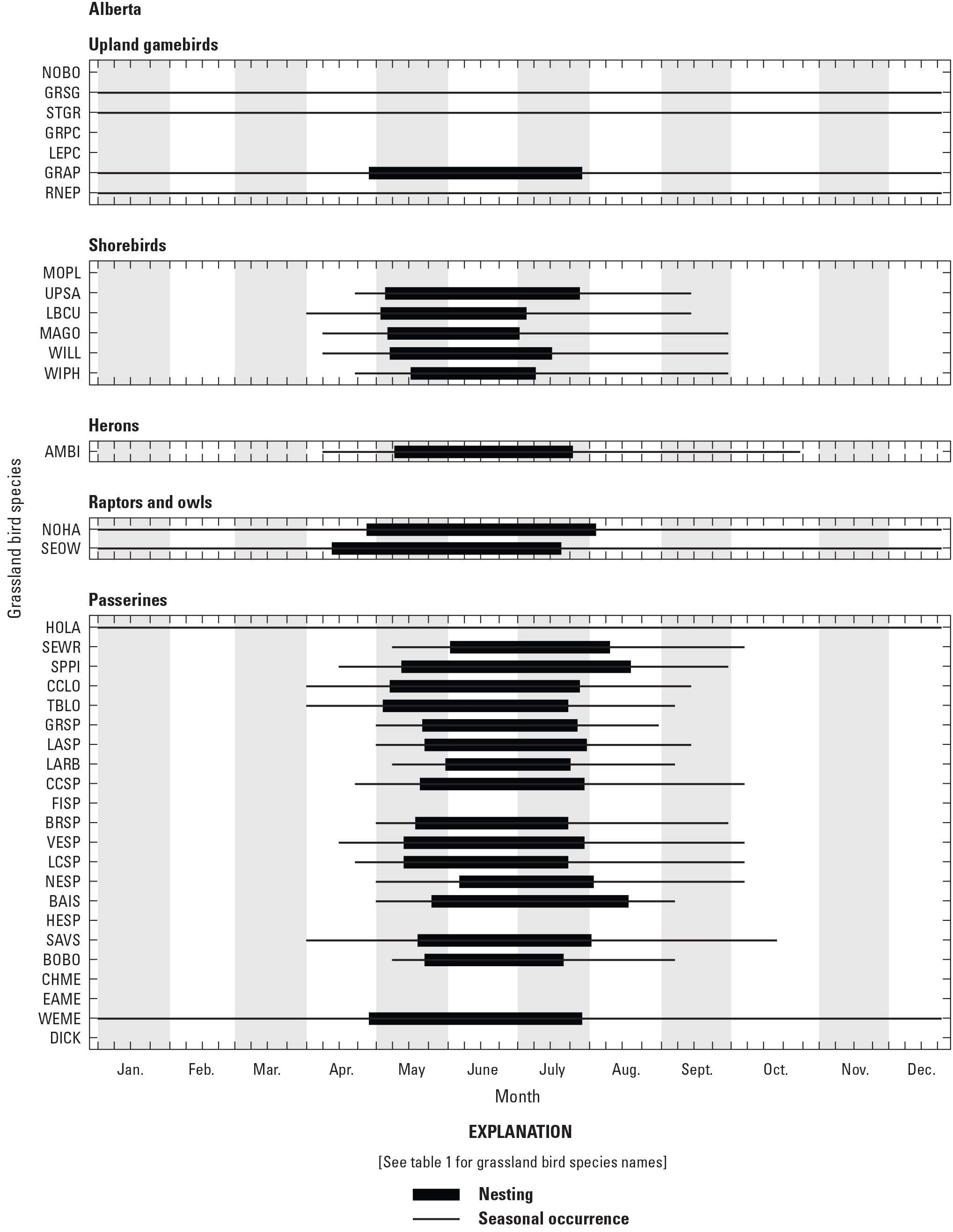
Seasonal occurrence and nesting phenology information for 38 species of grassland birds in Alberta, Canada (Rousseu and Drolet, 2015; eBird, 2023).
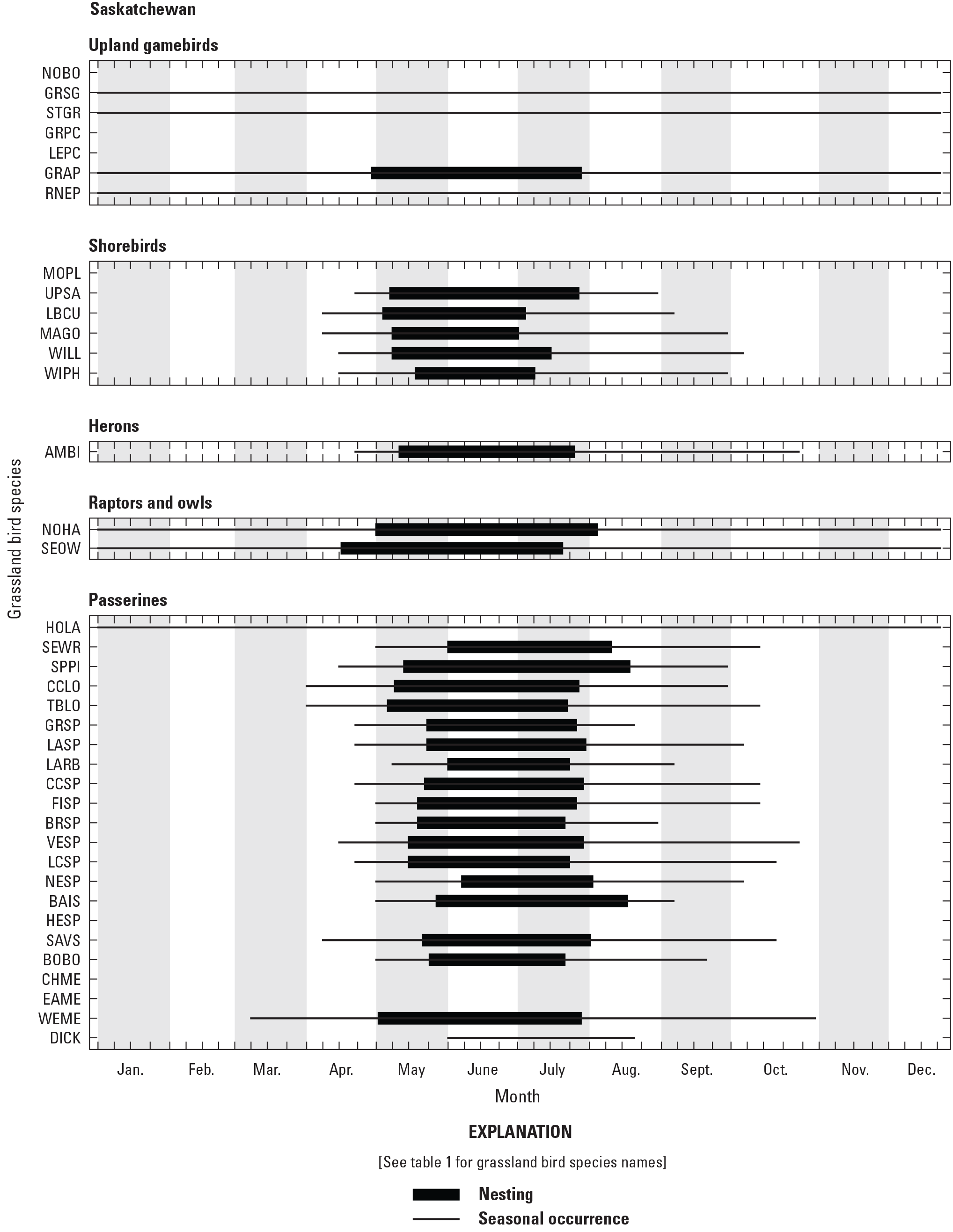
Seasonal occurrence and nesting phenology information for 38 species of grassland birds in Saskatchewan, Canada (Rousseu and Drolet, 2015; eBird, 2023).
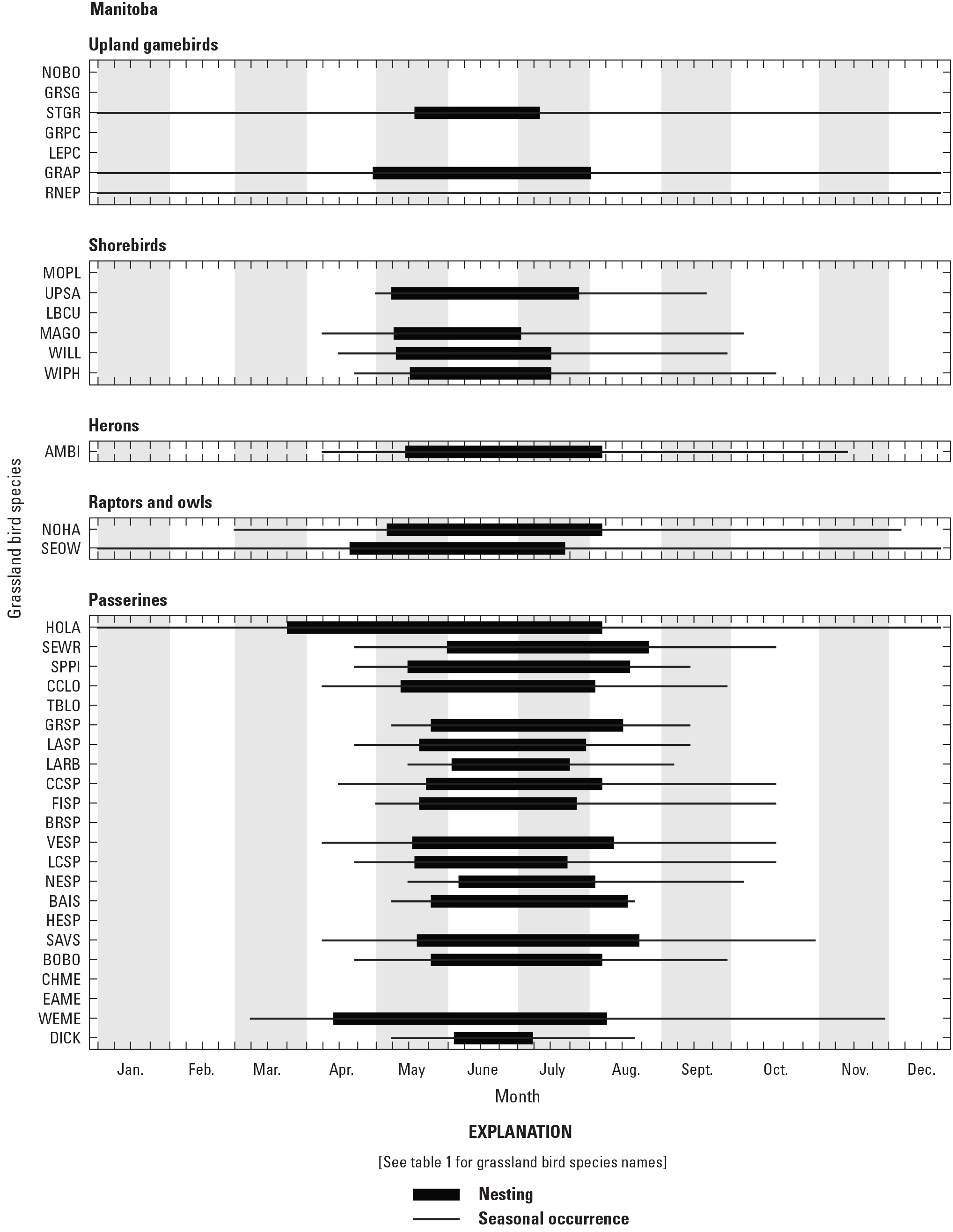
Seasonal occurrence and nesting phenology information for 38 species of grassland birds in Manitoba, Canada (Manitoba Avian Research Committee, 2003; Rousseu and Drolet, 2015; eBird, 2023).
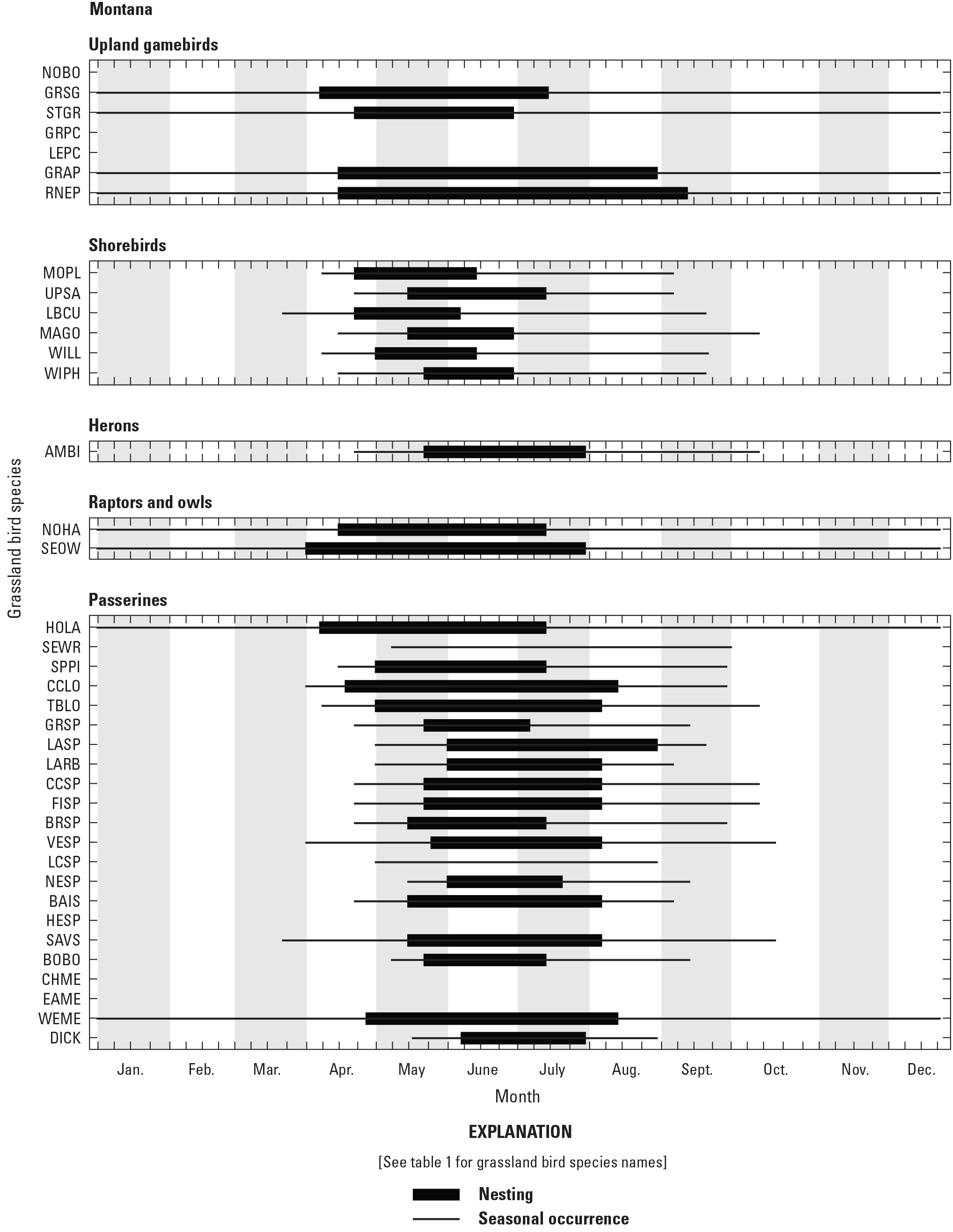
Seasonal occurrence and nesting phenology information for 38 species of grassland birds in Montana, United States (Marks and others, 2016; eBird, 2023).
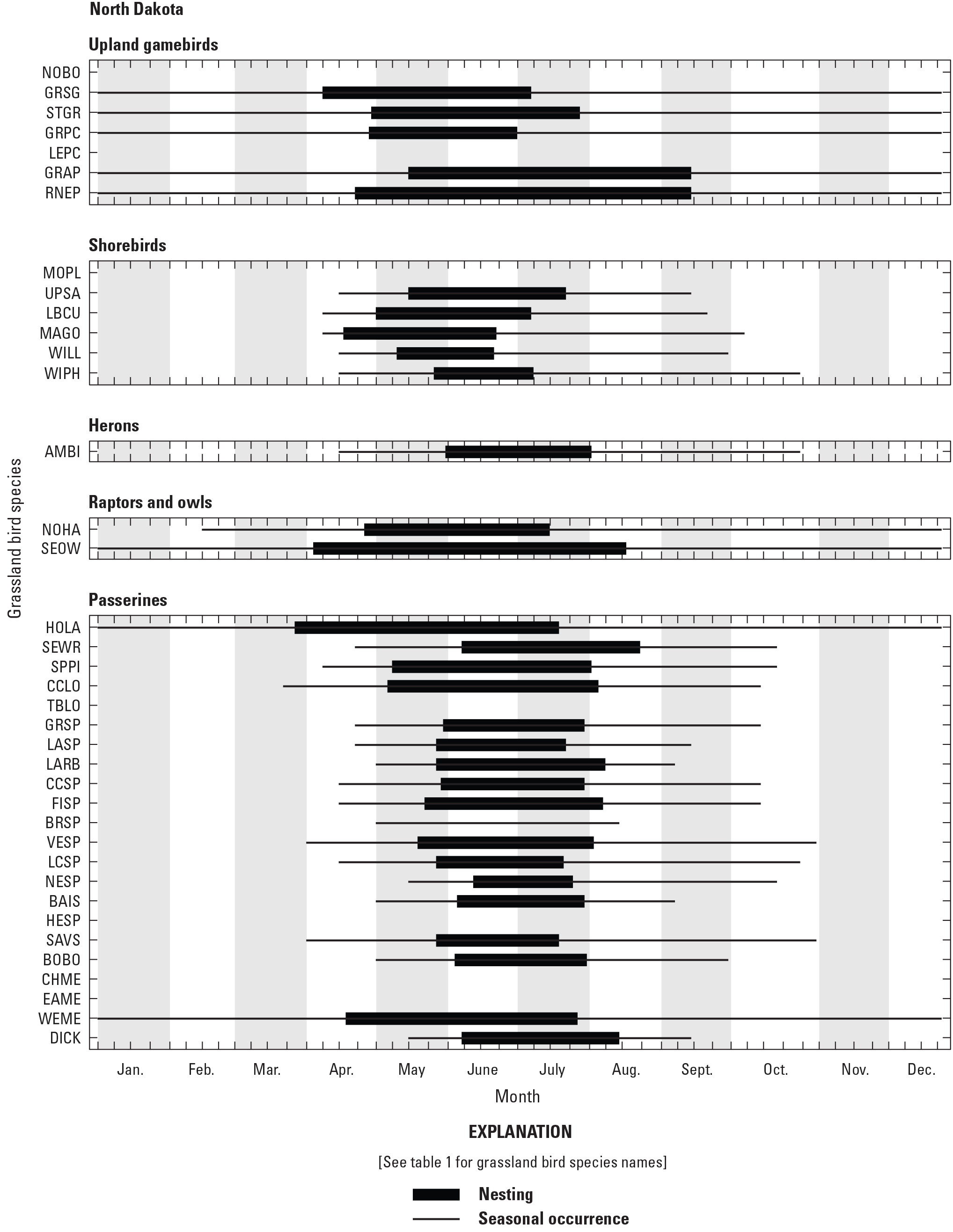
Seasonal occurrence and nesting phenology information for 38 species of grassland birds in North Dakota, United States (Stewart, 1975; eBird, 2023).
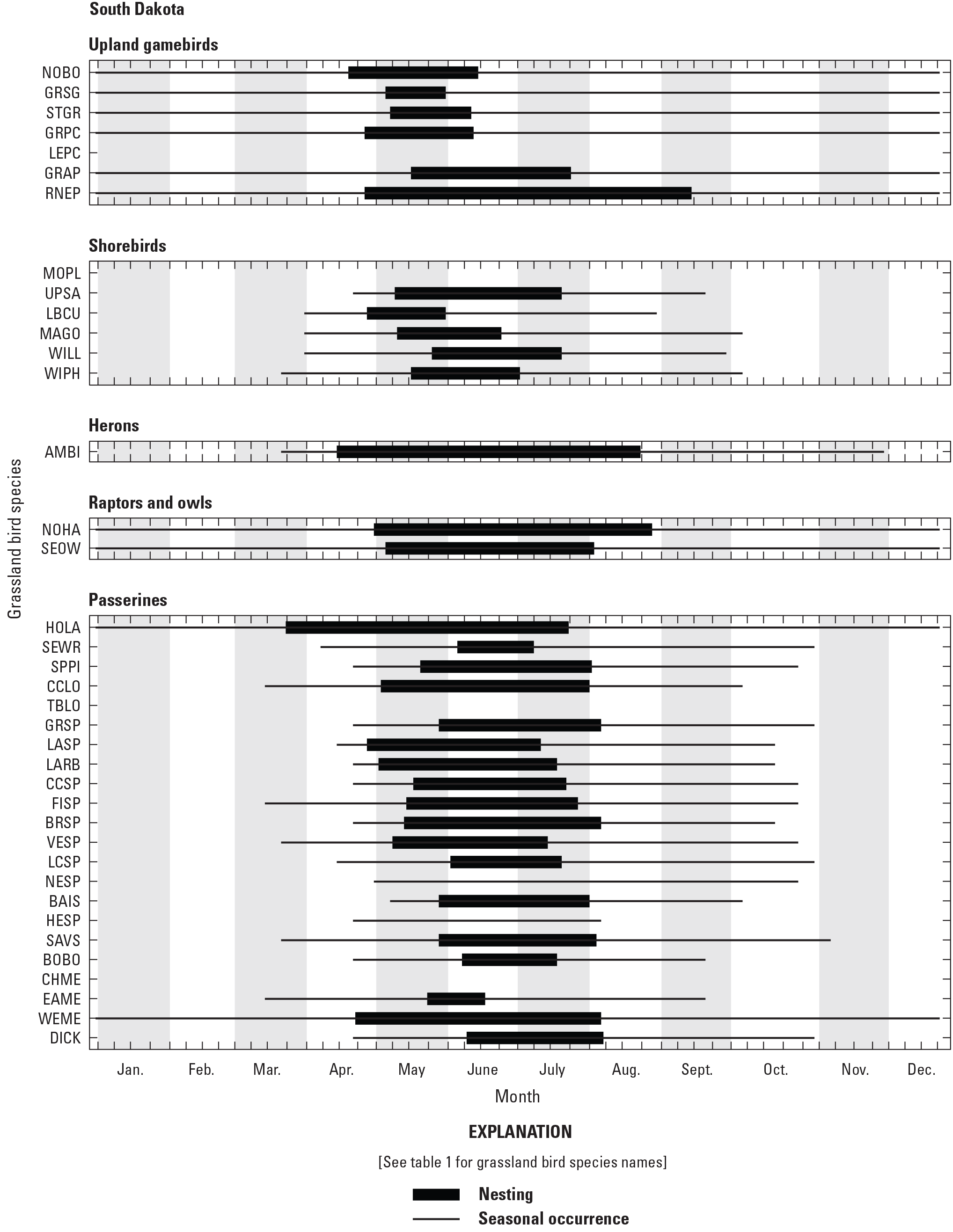
Seasonal occurrence and nesting phenology information for 38 species of grassland birds in South Dakota, United States (Whitney, 1978; South Dakota Ornithologists’ Union, 1991; Peterson, 1995; Tallman and others, 2002; eBird, 2023).
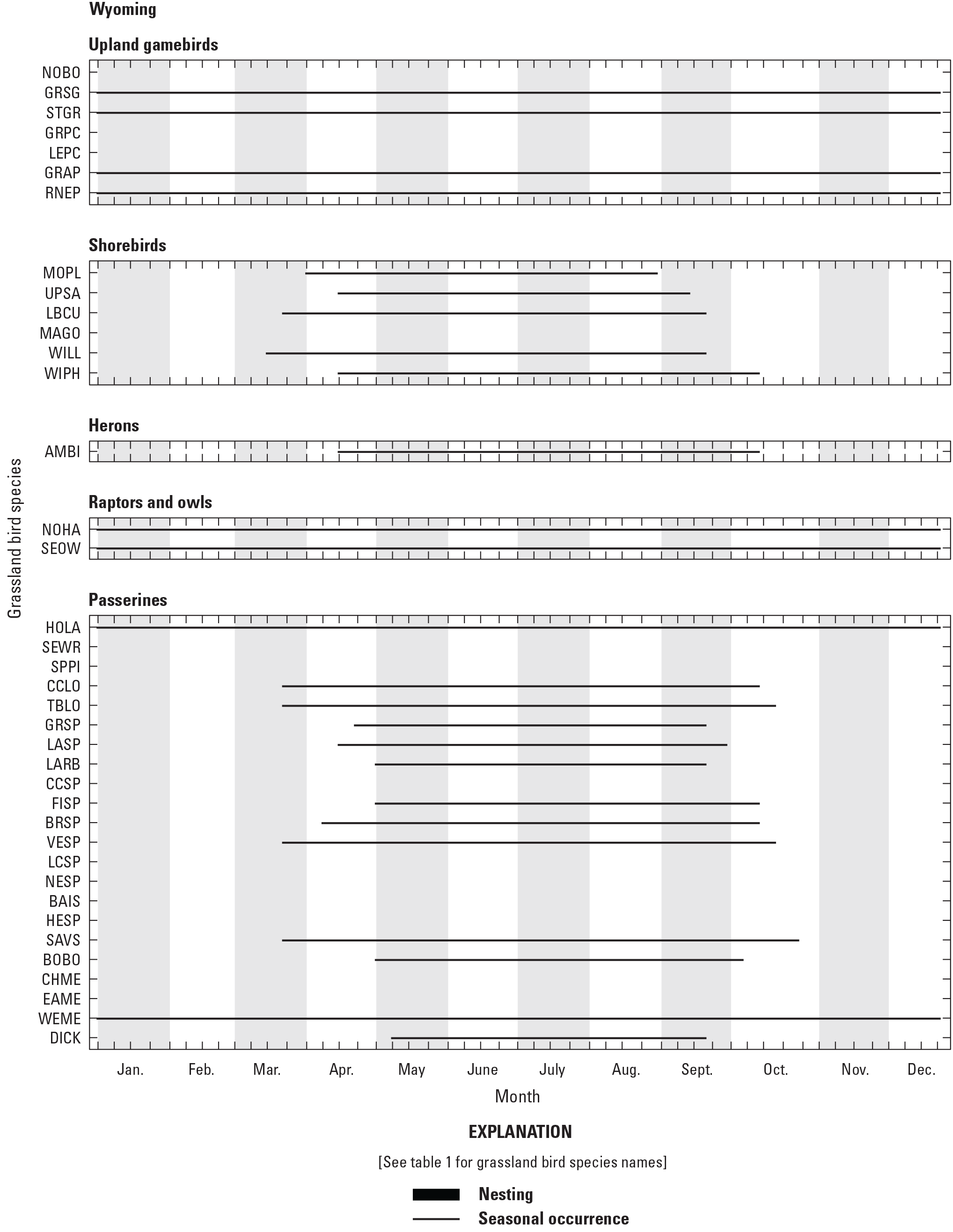
Seasonal occurrence information for 38 species of grassland birds in Wyoming, United States (eBird, 2023).
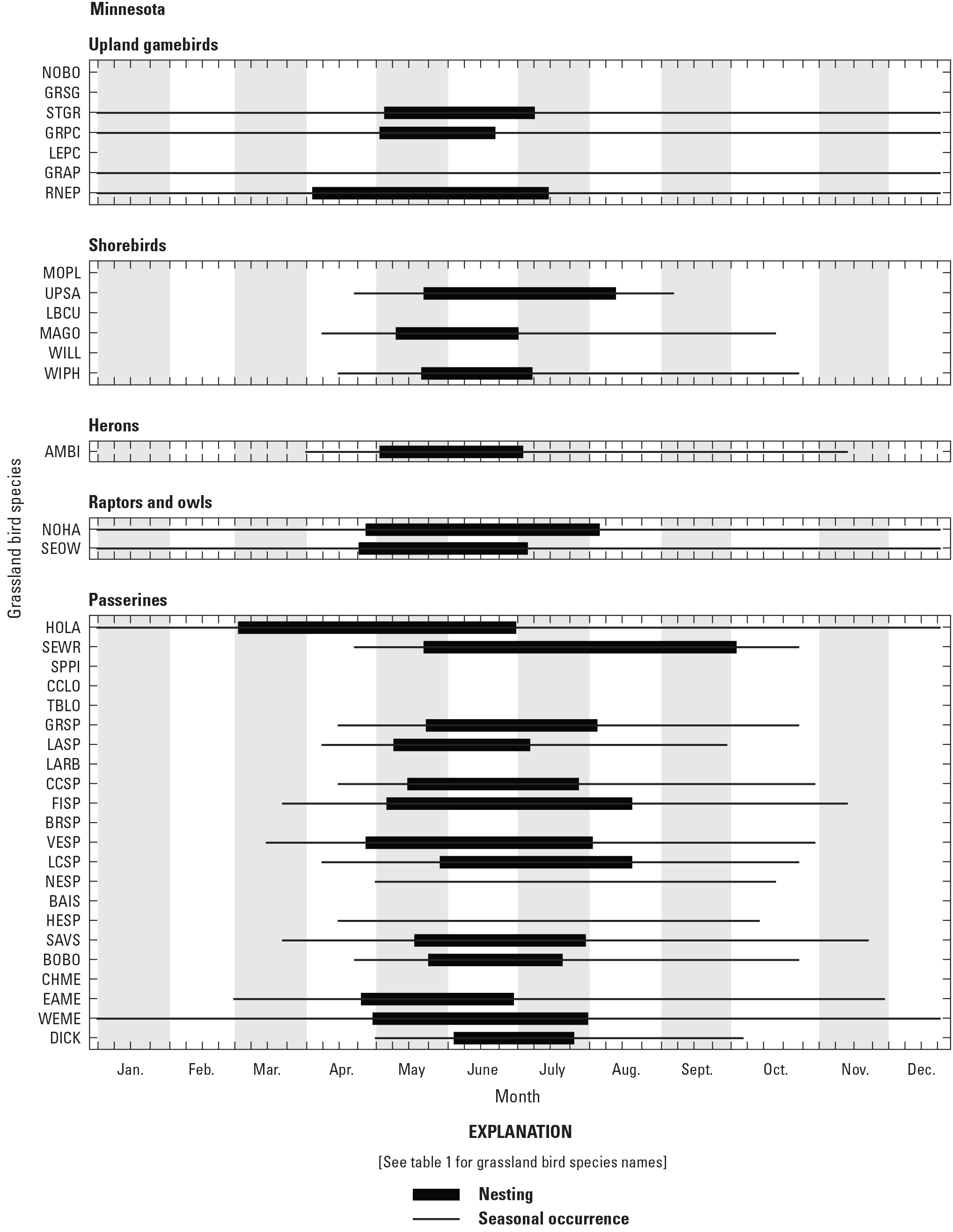
Seasonal occurrence and nesting phenology information for 38 species of grassland birds in Minnesota, United States (Roberts, 1932a, b105; eBird, 2023).
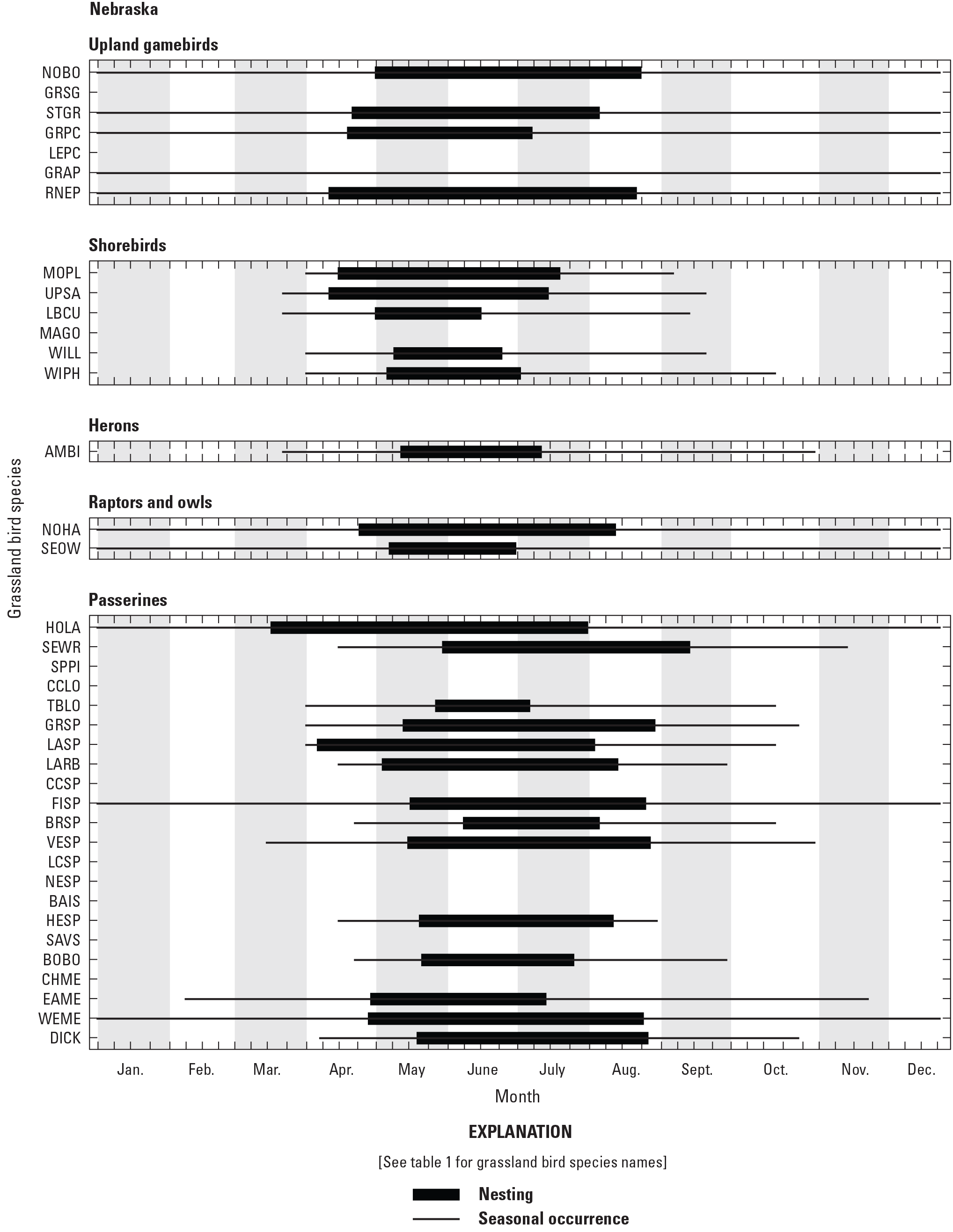
Seasonal occurrence and nesting phenology information for 38 species of grassland birds in Nebraska, United States (Mollhoff, 2022; eBird, 2023).
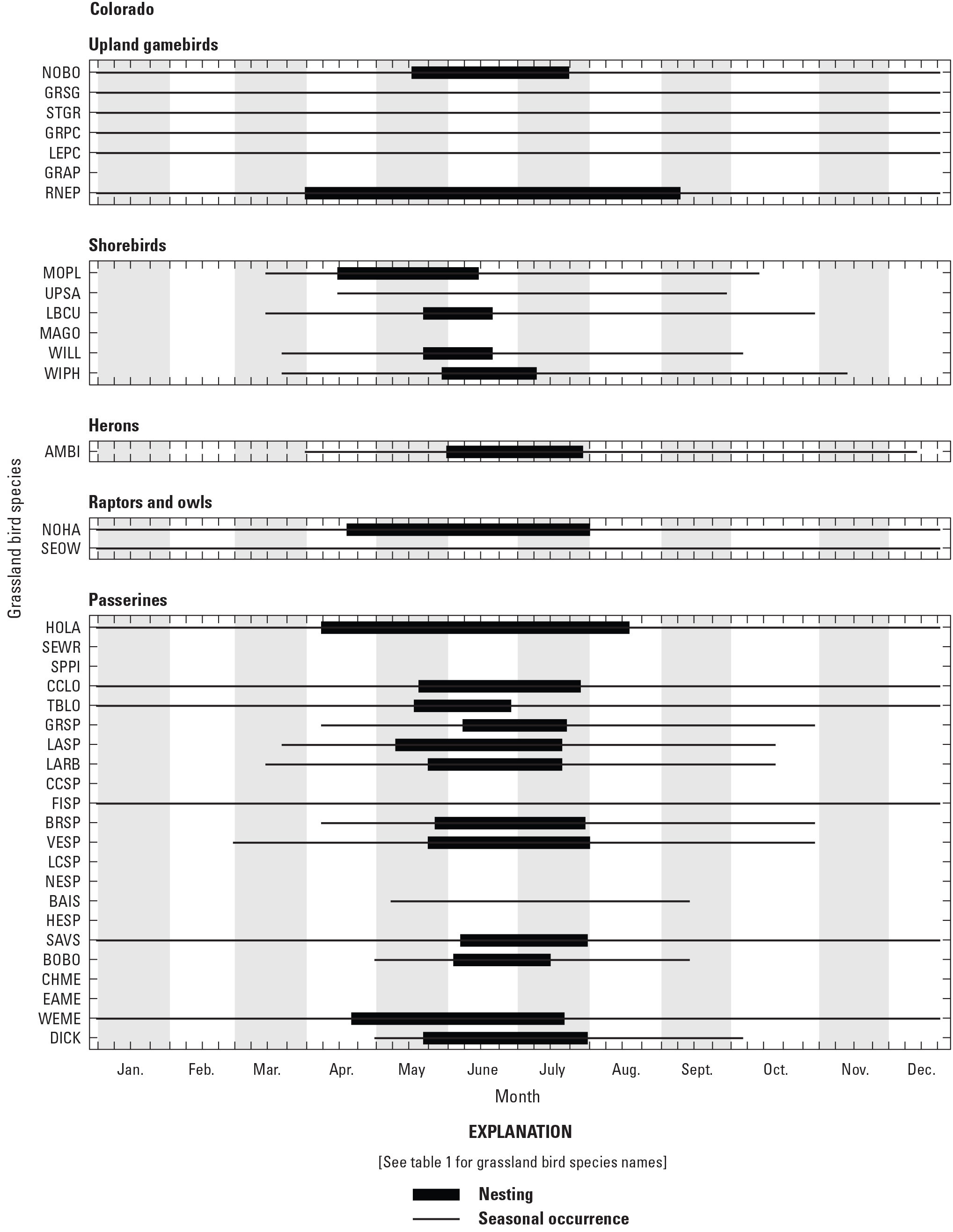
Seasonal occurrence and nesting phenology information for 38 species of grassland birds in Colorado, United States (Kingery, 1998; eBird, 2023).
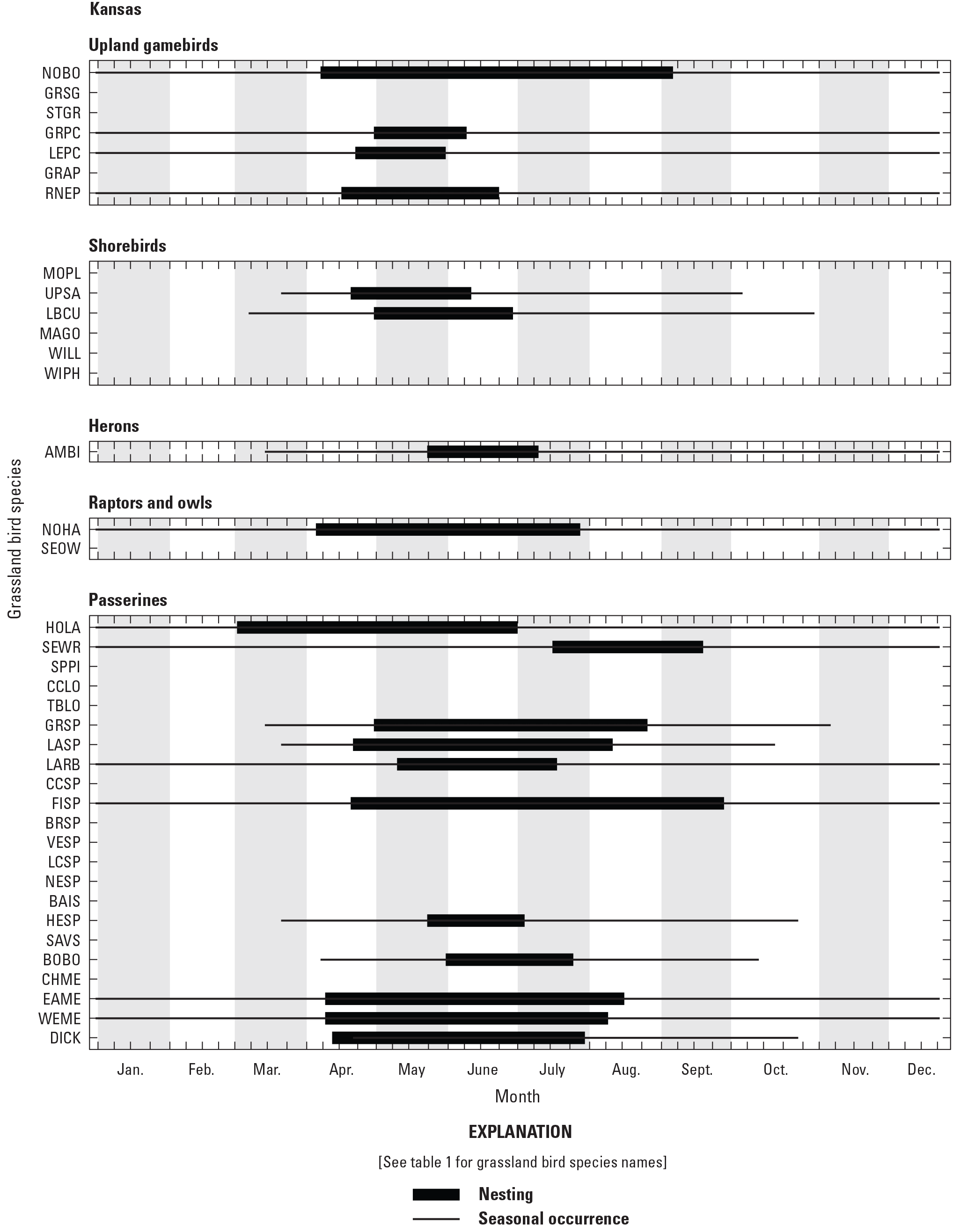
Seasonal occurrence and nesting phenology information for 38 species of grassland birds in Kansas, United States (Johnston, 1965; Thompson and Ely, 1989; Thompson and Ely, 1992; Thompson and others, 2011; eBird, 2023).
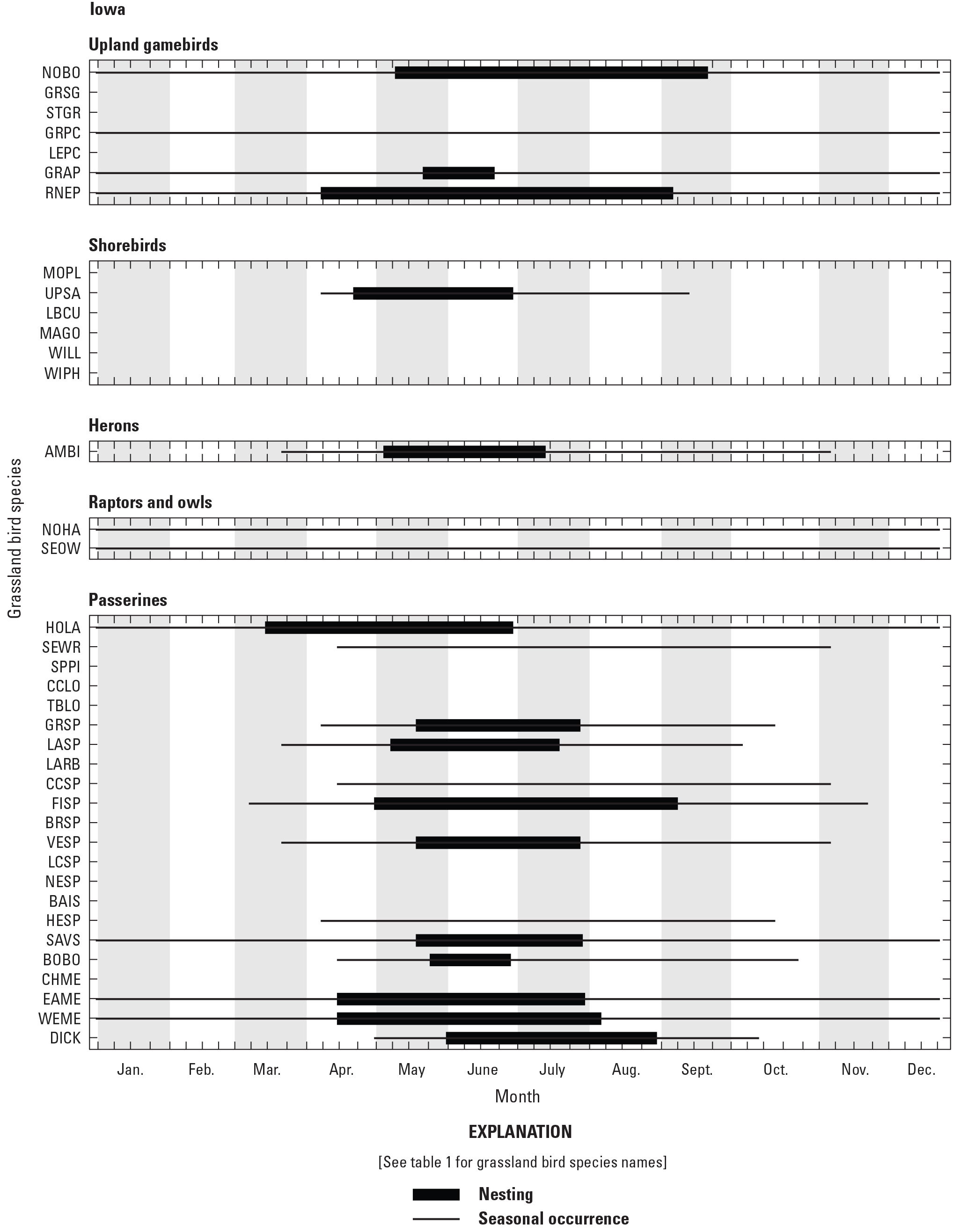
Seasonal occurrence and nesting phenology information for 38 species of grassland birds in Iowa, United States (Dinsmore and others, 1984; Jackson and others, 1996; eBird, 2023).
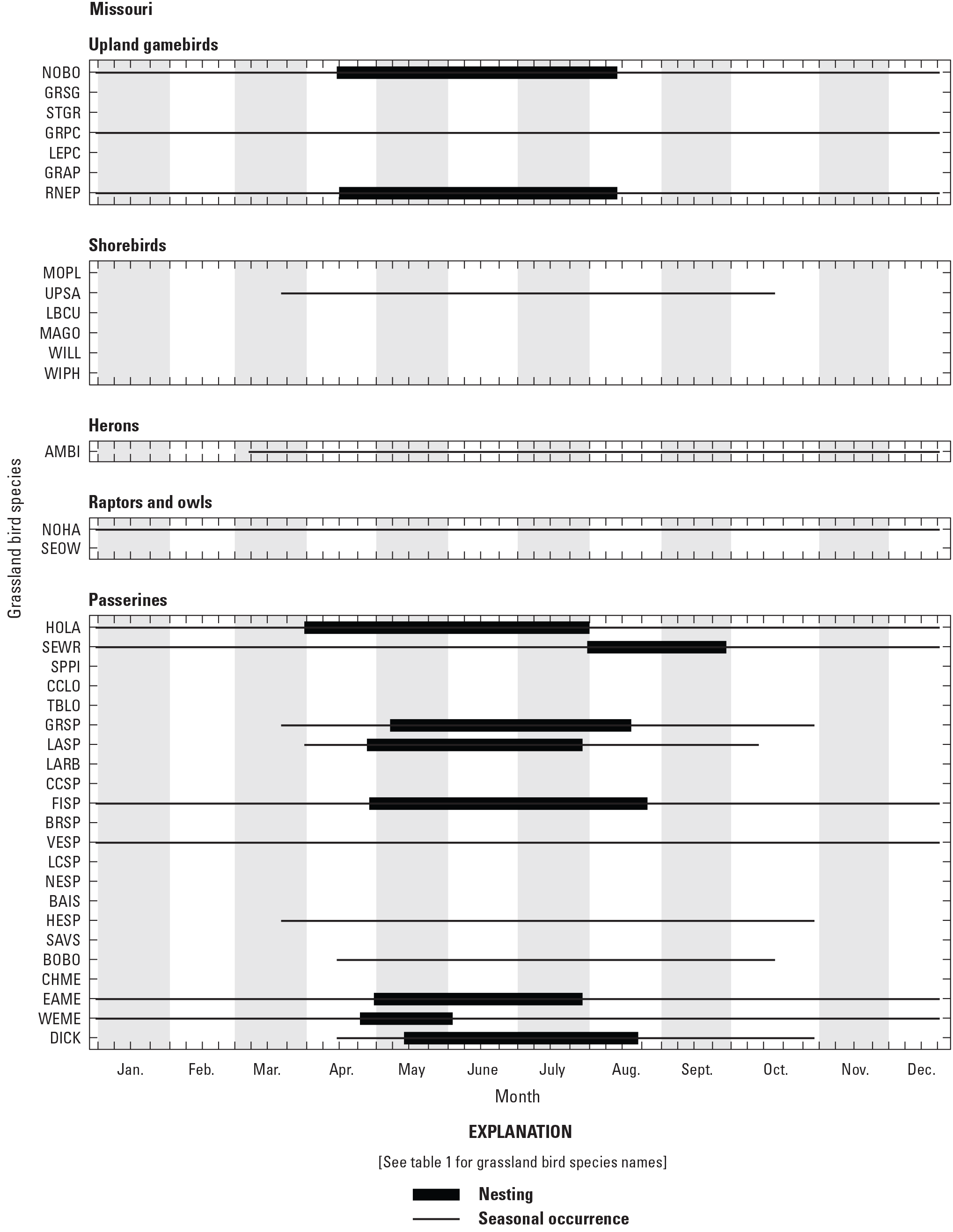
Seasonal occurrence and nesting phenology information for 38 species of grassland birds in Missouri, United States (Jacobs and Wilson, 1997; eBird, 2023).
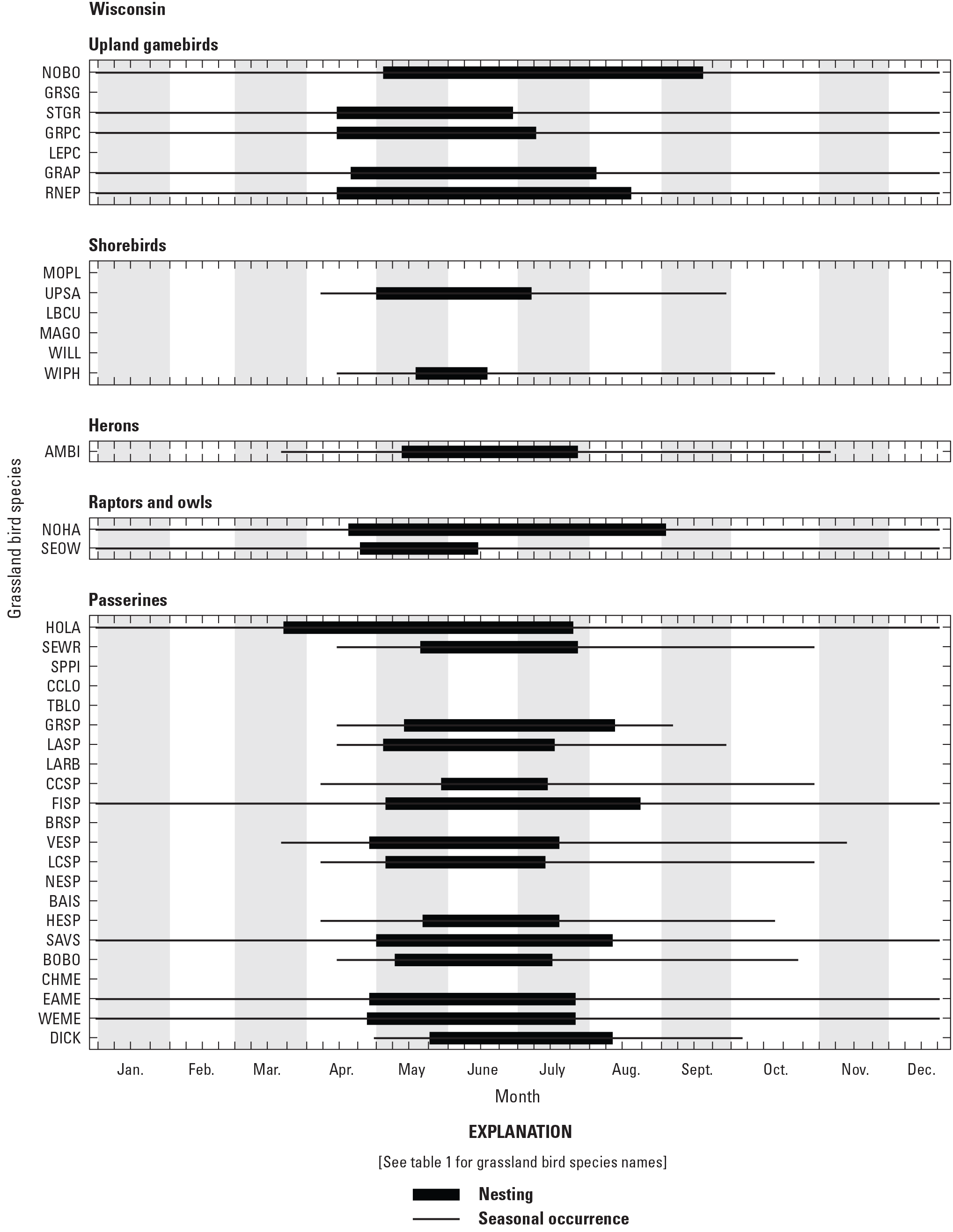
Seasonal occurrence and nesting phenology information for 38 species of grassland birds in Wisconsin, United States (Robbins, 1991; Cutright and others, 2006; eBird, 2023).
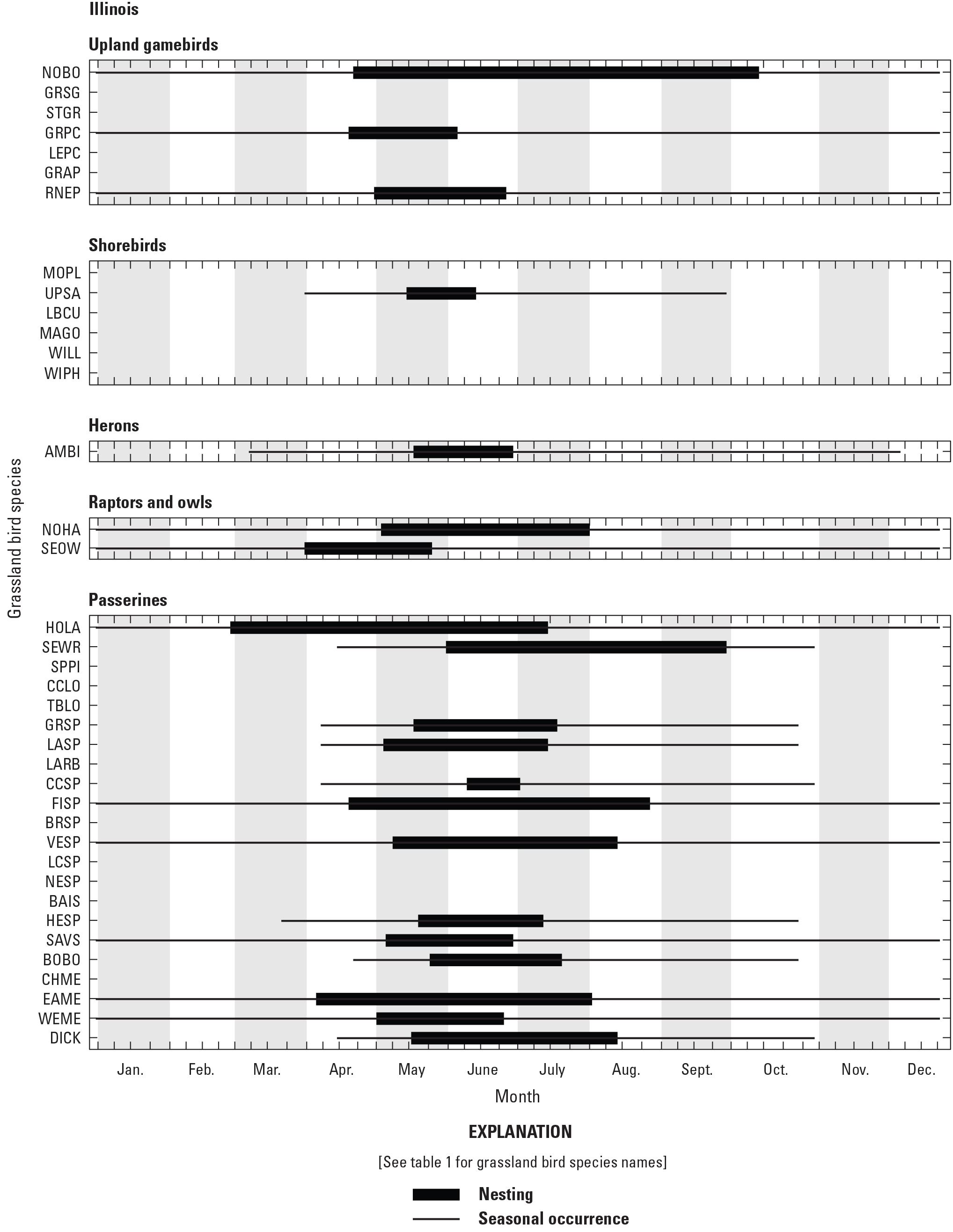
Seasonal occurrence and nesting phenology information for 38 species of grassland birds in Illinois, United States (Bohlen, 1989; eBird, 2023).
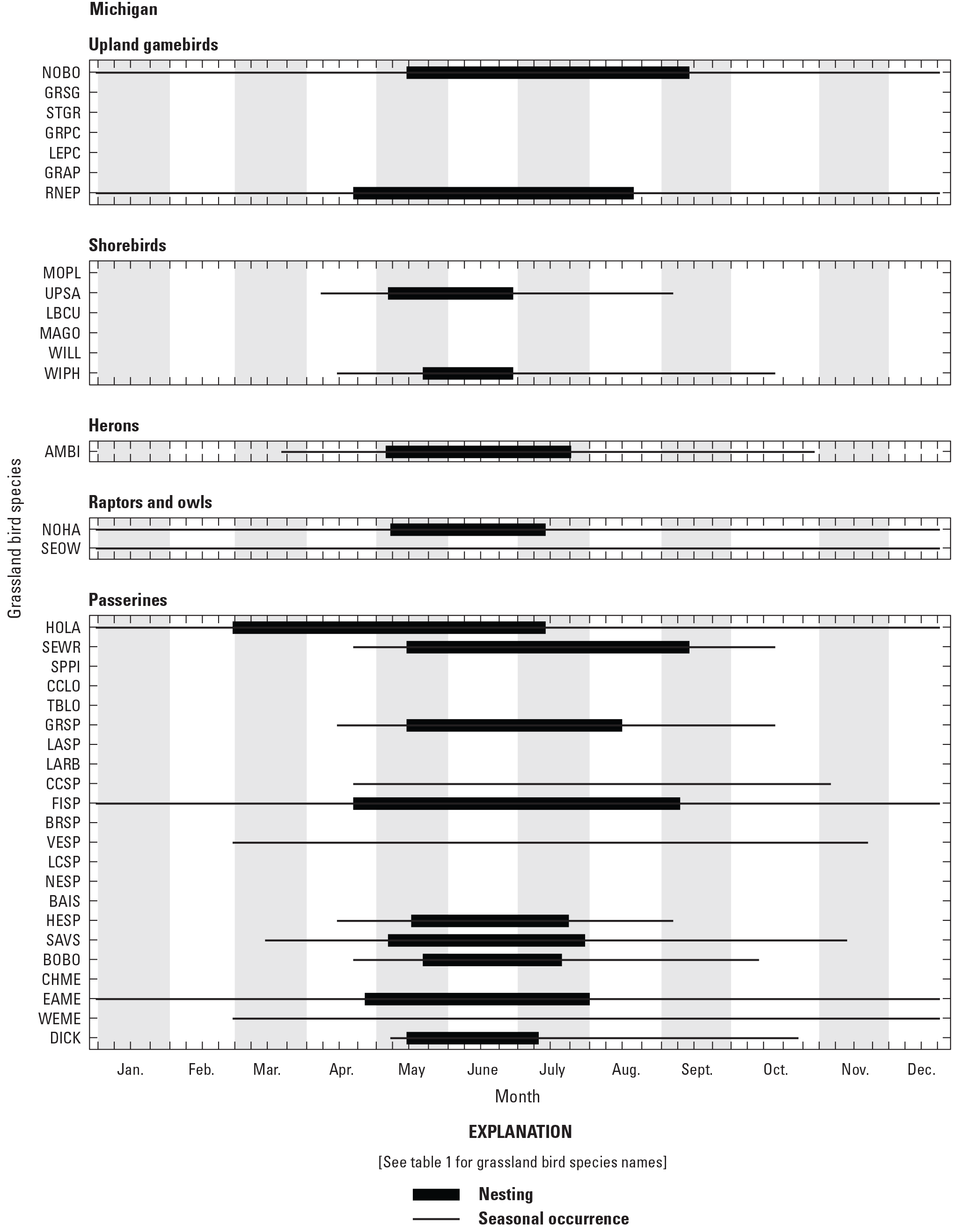
Seasonal occurrence and nesting phenology information for 38 species of grassland birds in Michigan, United States (Brewer and others, 1991; Granlund and McPeek, 1994; Chartier and others, 2013; eBird, 2023).
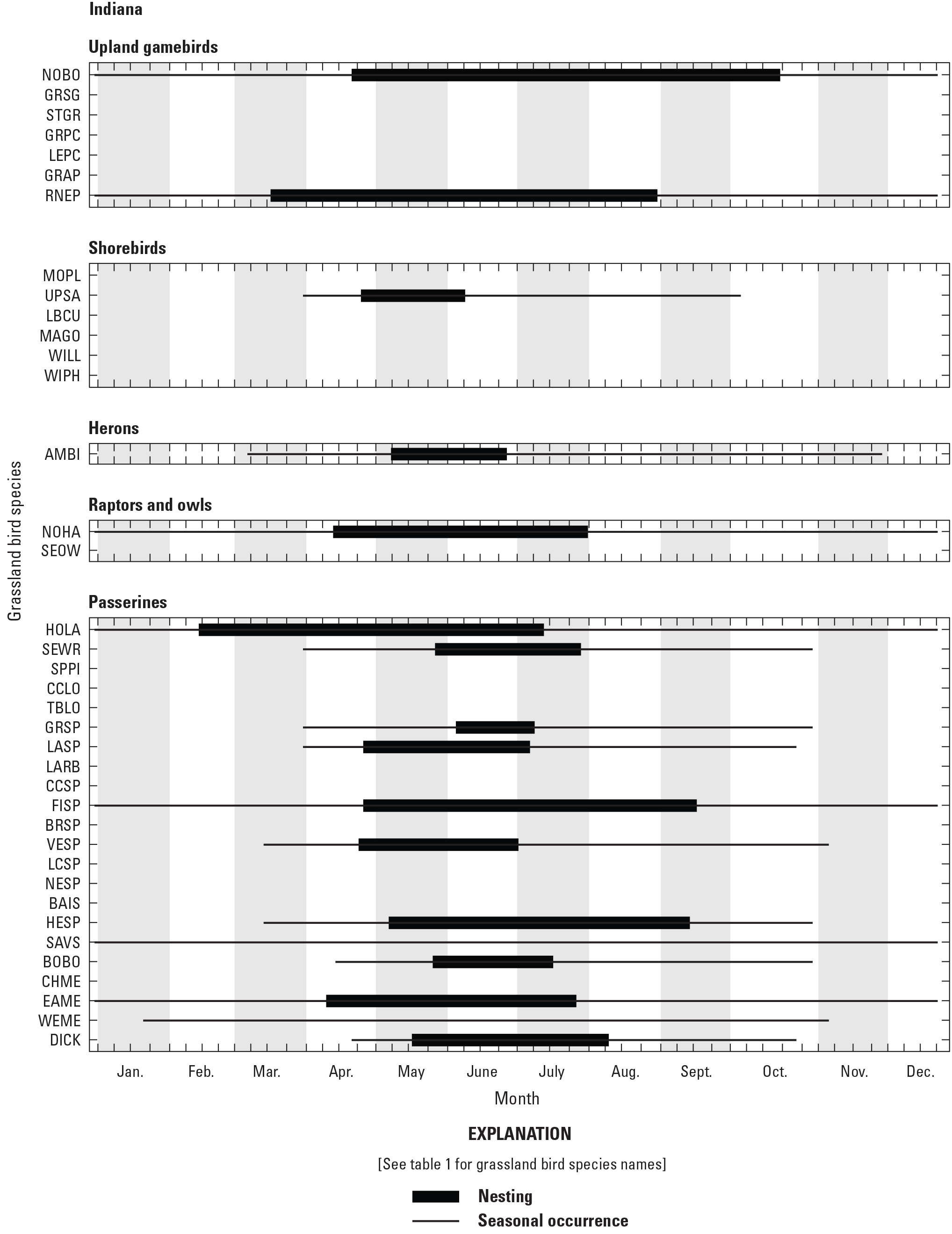
Seasonal occurrence and nesting phenology information for 38 species of grassland birds in Indiana, United States (Mumford and Keller, 1984; eBird, 2023).
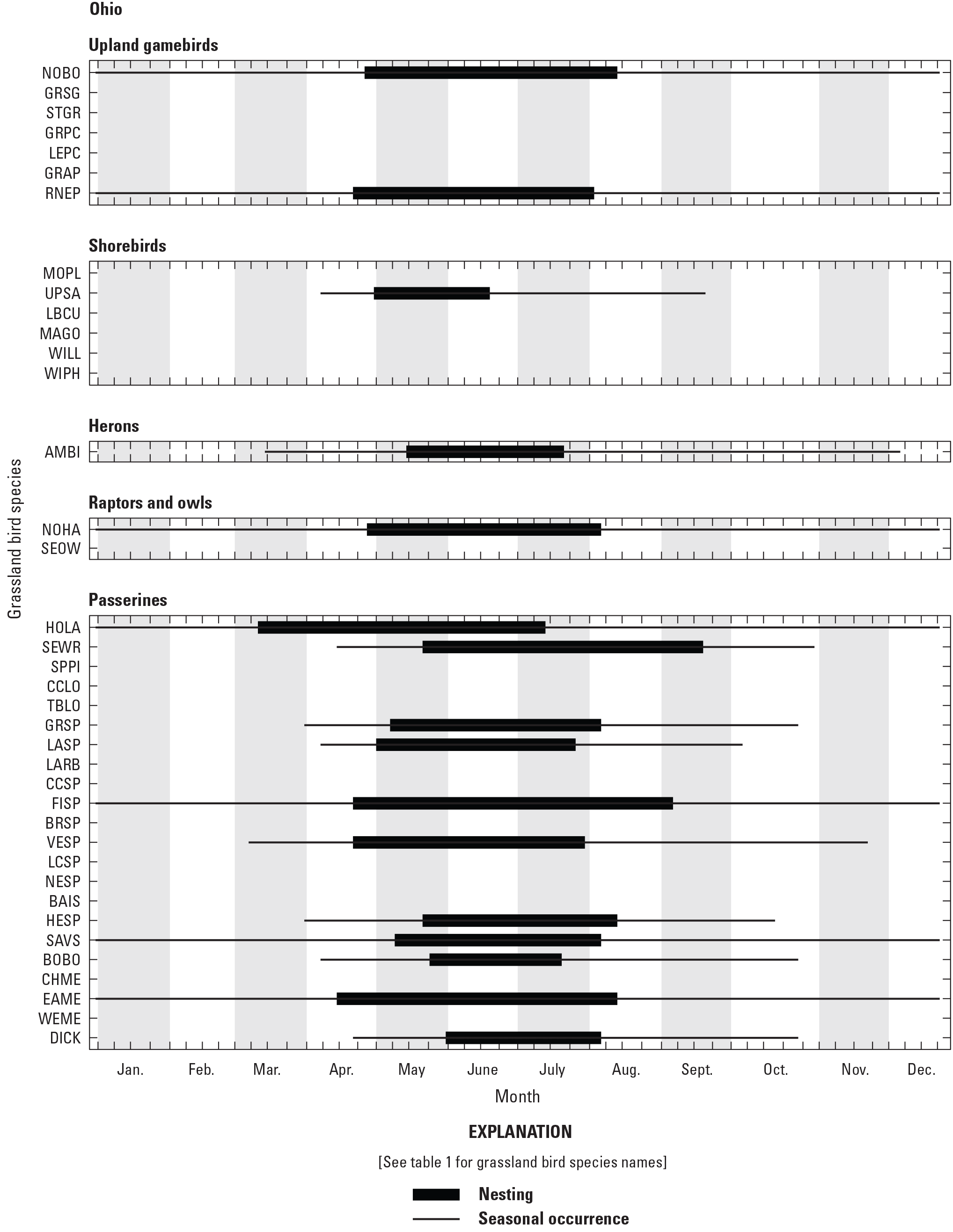
Seasonal occurrence and nesting phenology information for 38 species of grassland birds in Ohio, United States (Peterjohn, 2001; eBird, 2023).
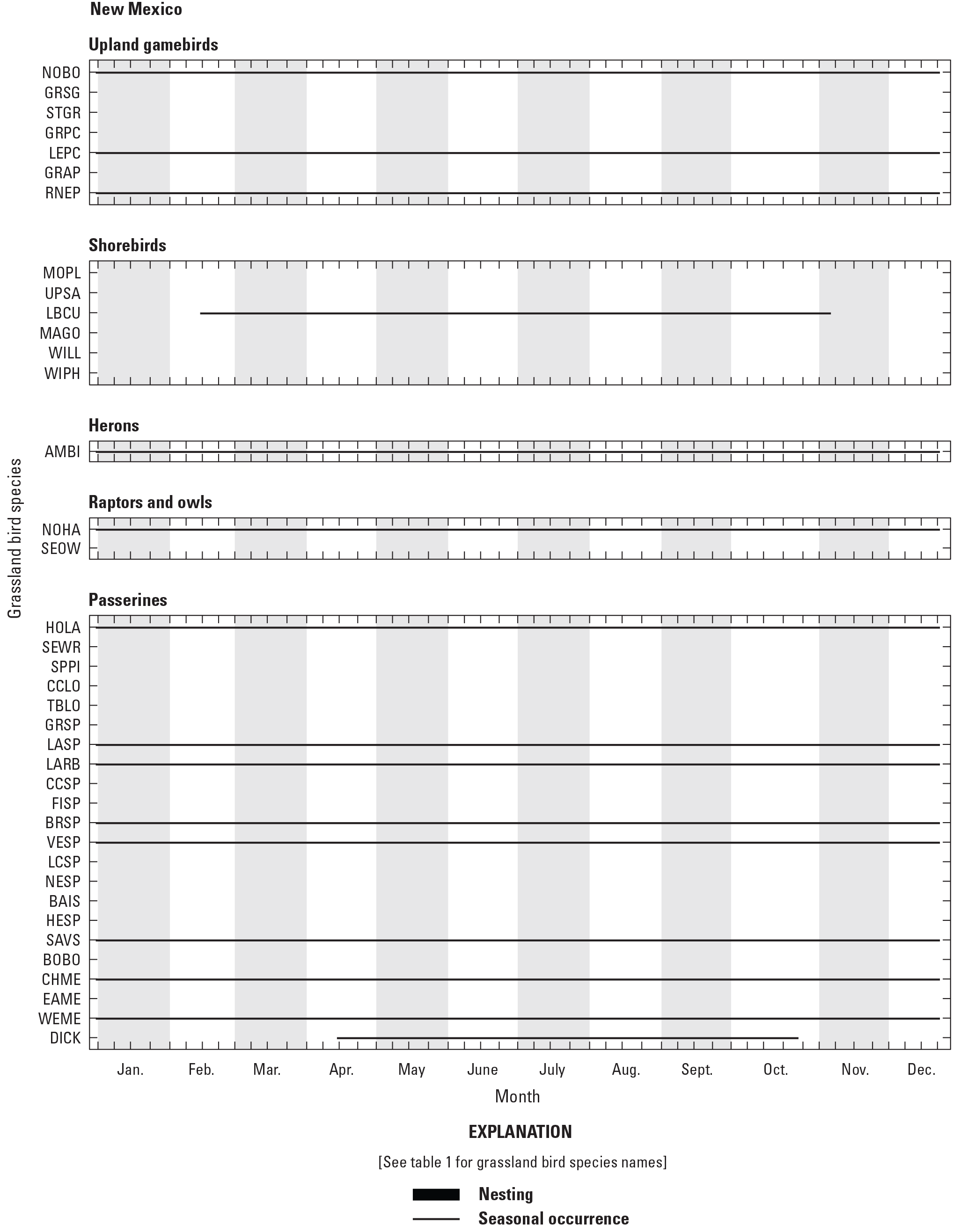
Seasonal occurrence information for 38 species of grassland birds in New Mexico, United States (eBird, 2023).
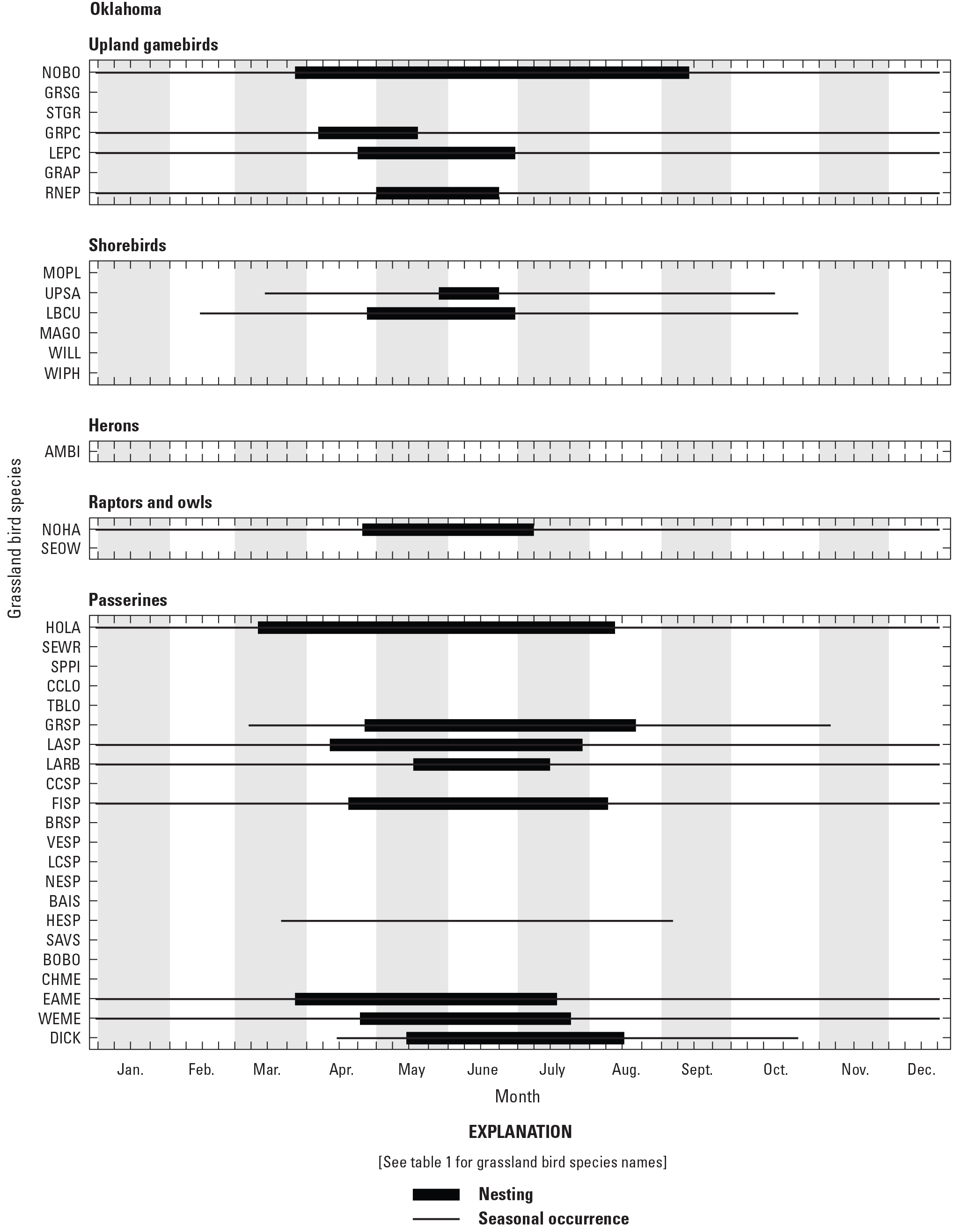
Seasonal occurrence and nesting phenology information for 38 species of grassland birds in Oklahoma, United States (Baumgartner and Baumgartner, 1992; eBird, 2023).
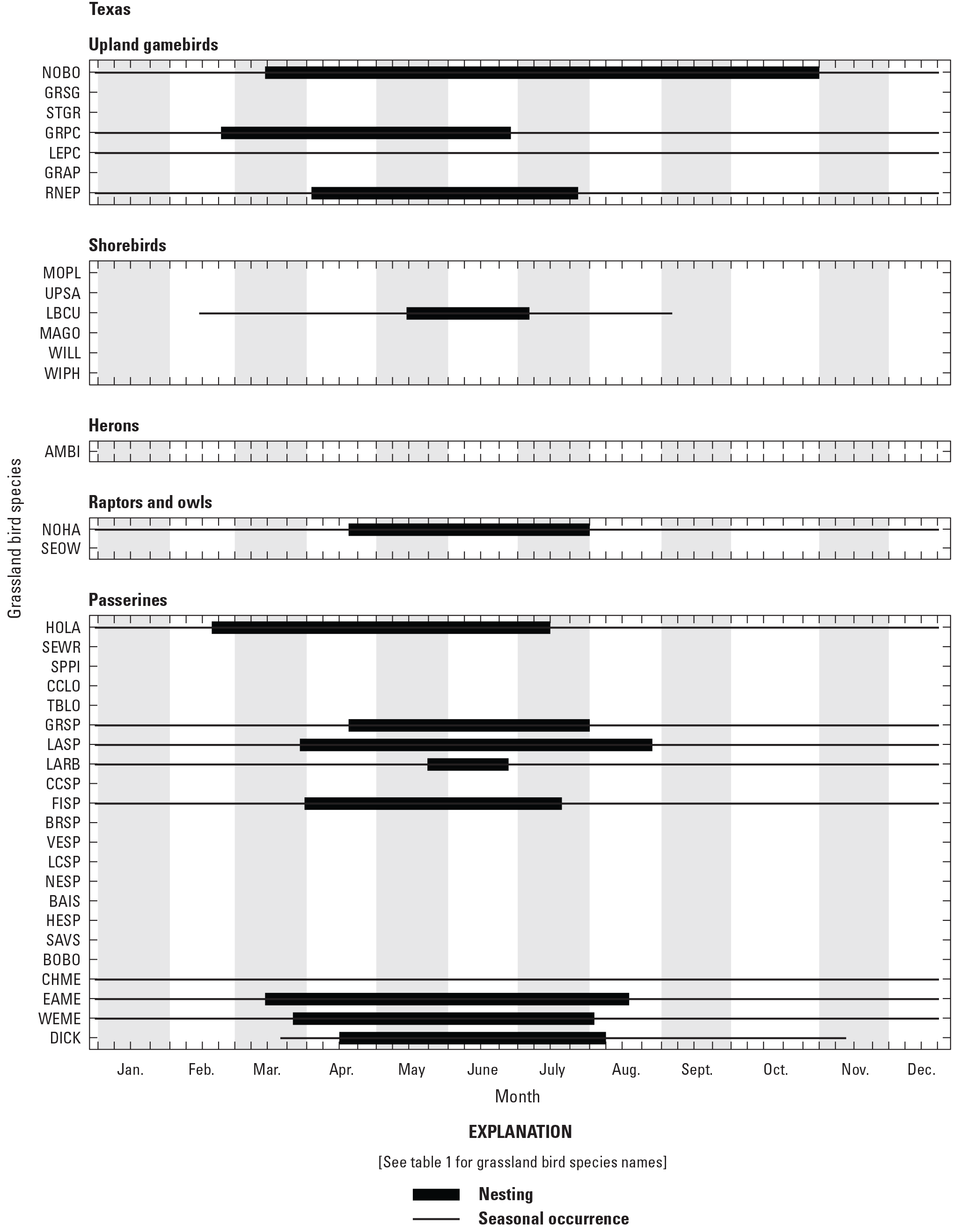
Seasonal occurrence and nesting phenology information for 38 species of grassland birds in Texas, United States (Oberholser, 1932; Benson and Arnold, 2001; eBird, 2023).
Appendix 2. List of Published Resources Searched for Nesting Phenology Information
Table 2.1.
List of published resources searched for nesting phenology information for 38 species of grassland birds in 18 States and 3 Provinces in the midcontinent of North America.References Cited
Benson, K.L.P., and Arnold, K.A., 2001, The Texas Breeding Bird Atlas: College Station and Corpus Christi, Tex., Texas A&M University System, accessed August 15, 2023, at https://txtbba.tamu.edu/.
eBird, 2023, eBird—An online database of bird distribution and abundance: Ithaca, N.Y., Cornell Lab of Ornithology database, accessed July 15, 2023, at https://www.ebird.org.
Iowa Ornithologists’ Union, 2020, Iowa Breeding Bird Atlas II: accessed August 15, 2023, at https://iowabba2.org/.
Knight, W.C., 1902, The birds of Wyoming: Laramie, Wyo., University of Wyoming, 174 p. [Also available at https://doi.org/10.5962/bhl.title.53932.]
Mollhoff, W.J., 2022, Nest records of Nebraska birds: Lincoln, Nebr., University of Nebraska-Lincoln Libraries, 111 p. [Also available at https://doi.org/10.32873/unl.dc.zea.1318.]
Pfannmuller, L, Niemi, G., Green, J., Sample, B., Walton, N., Zlonis, E., Brown, T., Bracey, A., Host, G., Reed, J., Rewinkel, K., and Will, N., 2017, The first Minnesota Breeding Bird Atlas (2009–2013): accessed June 15, 2023, at https://mnbirdatlas.org/.
Rousseu, F., and Drolet, B., 2015, Prediction of the nesting phenology of birds in Canada, in Hussell, J., and Lepage, D., Nesting Calendar Query Tool—Project NestWatch: Port Rowan, Ontario, Bird Studies Canada, accessed August 25, 2023, at https://naturecounts.ca/apps/rnest/index.jsp.
U.S. Geological Survey, 2014, Breeding Bird Atlas Explorer: U.S. Geological Survey Patuxent Wildlife Research Center, accessed September 7, 2023, at https://www.pwrc.usgs.gov/bba/index.cfm.
For more information about this publication, contact:
Director, USGS Northern Prairie Wildlife Research Center
8711 37th Street Southeast
Jamestown, ND 58401
701–253–5500
For additional information, visit: https://www.usgs.gov/centers/npwrc
Publishing support provided by the
Rolla Publishing Service Center
Disclaimers
Any use of trade, firm, or product names is for descriptive purposes only and does not imply endorsement by the U.S. Government.
Although this information product, for the most part, is in the public domain, it also may contain copyrighted materials as noted in the text. Permission to reproduce copyrighted items must be secured from the copyright owner.
Suggested Citation
MacDonald, G.J., Anteau, M.J., Ellis, K.S., Igl, L.D., Niemuth, N.D., and Vest, J.L., 2024, Seasonal and breeding phenologies of 38 grassland bird species in the midcontinent of North America: U.S. Geological Survey Open-File Report 2024–1002, 43 p., https://doi.org/10.3133/ofr20241002.
ISSN: 2331-1258 (online)
| Publication type | Report |
|---|---|
| Publication Subtype | USGS Numbered Series |
| Title | Seasonal and breeding phenologies of 38 grassland bird species in the midcontinent of North America |
| Series title | Open-File Report |
| Series number | 2024-1002 |
| DOI | 10.3133/ofr20241002 |
| Publication Date | January 24, 2024 |
| Year Published | 2024 |
| Language | English |
| Publisher | U.S. Geological Survey |
| Publisher location | Reston, VA |
| Contributing office(s) | Northern Prairie Wildlife Research Center |
| Description | vi, 43 p. |
| Online Only (Y/N) | Y |
| Additional Online Files (Y/N) | N |


